A financial cybercrime group calling itself the Disneyland Team has been making liberal use of visually confusing phishing domains that spoof popular bank brands using Punycode, an Internet standard that allows web browsers to render domain names with non-Latin alphabets like Cyrillic.
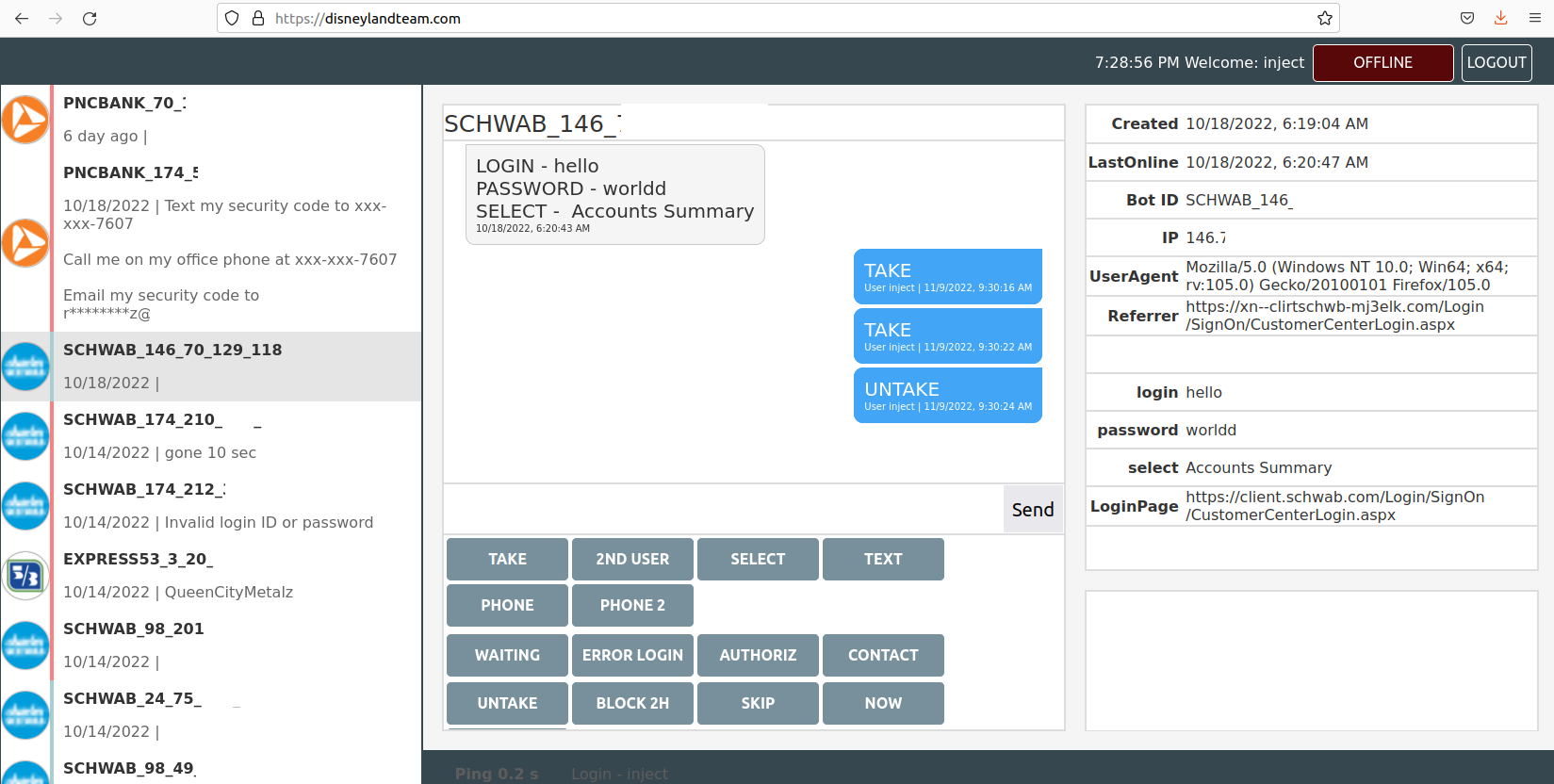
The Disneyland Team’s Web interface, which allows them to interact with malware victims in real time to phish their login credentials using phony bank websites.
The Disneyland Team uses common misspellings for top bank brands in its domains. For example, one domain the gang has used since March 2022 is ushank[.]com — which was created to phish U.S. Bank customers.
But this group also usually makes use of Punycode to make their phony bank domains look more legit. The U.S. financial services firm Ameriprise uses the domain ameriprise.com; the Disneyland Team’s domain for Ameriprise customers is https://www.xn--meripris-mx0doj[.]com [brackets added to defang the domain], which displays in the browser URL bar as ạmeriprisẹ[.]com.
Look carefully, and you’ll notice small dots beneath the “a” and the second “e”. You could be forgiven if you mistook one or both of those dots for a spec of dust on your computer screen or mobile device.
This candid view inside the Disneyland Team comes from Alex Holden, founder of the Milwaukee-based cybersecurity consulting firm Hold Security. Holden’s analysts gained access to a Web-based control panel the crime group has been using to keep track of victim credentials (see screenshot above). The panel reveals the gang has been operating dozens of Punycode-based phishing domains for the better part of 2022.
Have a look at the Punycode in this Disneyland Team phishing domain: https://login2.xn--mirtesnbd-276drj[.]com, which shows up in the browser URL bar as login2.ẹmirạtesnbd[.]com, a domain targeting users of Emirates NBD Bank in Dubai.
Here’s another domain registered this year by the Disneyland Team: https://xn--clientchwb-zxd5678f[.]com, which spoofs the login page of financial advisor Charles Schwab with the landing page of cliẹntșchwab[.]com. Again, notice the dots under the letters “e” and “s”. Another Punycode domain of theirs sends would-be victims to cliẹrtschwạb[.]com, which combines a brand misspelling with Punycode.
We see the same dynamic with the Disneyland Team Punycode domain https://singlepoint.xn--bamk-pxb5435b[.]com, which translates to singlepoint.ụșbamk[.]com — again phishing U.S. Bank customers.
What’s going on here? Holden says the Disneyland Team is Russian-speaking — if not also based in Russia — but it is not a phishing gang per se. Rather, this group uses the phony bank domains in conjunction with malicious software that is already secretly installed on a victim’s computer.
Holden said the Disneyland Team domains were made to help the group steal money from victims infected with a powerful strain of Microsoft Windows-based banking malware known as Gozi 2.0/Ursnif. Gozi specializes in collecting credentials, and is mainly used for attacks on client-side online banking to facilitate fraudulent bank transfers. Gozi also allows the attackers to connect to a bank’s website using the victim’s computer.
In years past, crooks like these would use custom-made “web injects” to manipulate what Gozi victims see in their Web browser when they visit their bank’s site. These web injects allowed malware to rewrite the bank’s HTML code on the fly, and copy and/or intercept any data users would enter into a web-based form, such as a username and password.
Most Web browser makers, however, have spent years adding security protections to block such nefarious activity. As a result, the Disneyland Team simply tries to make their domains look as much like the real thing as possible, and then funnel victims toward interacting with those imposter sites.
“The reason that it is infeasible for them to use in-browser injects include browser and OS protection measures, and difficulties manipulating dynamic pages for banks that require multi-factor authentication,” Holden said.
In reality, the fake bank website overlaid by the Disneyland Team’s malware relays the victim’s browser activity through to the real bank website, while allowing the attackers to forward any secondary login requests from the bank, such as secret questions or multi-factor authentication challenges.
The Disneyland Team included instructions for its users, noting that when the victim enters their login credentials, he sees a 10-second spinning wheel, and then the message, “Awaiting back office approval for your request. Please don’t close this window.”

A fake PNC website overlay or “web inject” displaying a message intended to temporarily prevent the user from accessing their account.
The “SKIP” button in the screenshot above sends the user to the real bank login page, “in case the account is not interesting to us,” the manual explains. “Also, this redirect works if none of our operators are working at the time.”
The “TAKE” button in the Disneyland Team control panel allows users or affiliates to claim ownership over a specific infected machine or bot, which then excludes other users from interacting with that victim.
In the event that it somehow takes a long time to get the victim (bot) connected to the Disneyland Team control panel, or if it is necessary to delay a transaction, users can push a button that prompts the following message to appear on the victim’s screen:
“Your case ID number is 875472. An online banking support representative will get in touch shortly. Please provide your case ID number, and DO NOT close this page.”
The Disneyland user manual explains that the panel can be used to force the victim to log in again if they transmit invalid credentials. It also has other options for stalling victims whilst their accounts are drained. Another fake prompt the panel can produce shows the victim a message saying, “We are currently working on updating our security system. You should be able to log in once the countdown timer expires.”
The user manual says this option blocks the user from accessing their account for two hours. “It is possible to block for an hour with this button, in this case they get less frustrated, within the hours ddos will kill their network.”
Cybercrime groups will sometimes launch distributed denial-of-service (DDoS) attacks on the servers of the companies they’re trying to rob — which is usually intended to distract victims from their fleecing, although Holden said it’s unclear if the Disneyland Team employs this tactic as well.
For many years, KrebsOnSecurity tracked the day-to-day activities of a similar malware crew that used web injects and bots to steal tens of millions of dollars from small- to mid-sized businesses across the United States.
At the end of each story, I would close with a recommendation that anyone concerned about malware snarfing their banking information should strongly consider doing their online banking from a dedicated, security-hardened system which is only used for that purpose. Of course, the dedicated system approach works only if you always use that dedicated system for managing your account online.
Those stories also observed that since the vast majority of the malicious software used in cyberheists is designed to run only on Microsoft Windows computers, it made sense to pick a non-Windows computer for that dedicated banking system, such as a Mac or even a version of Linux. I still stand by this advice.
In case anyone is interested, here (PDF) is a list of all phishing domains currently and previously used by the Disneyland Team.
Vyacheslav “Tank” Penchukov, the accused 40-year-old Ukrainian leader of a prolific cybercriminal group that stole tens of millions of dollars from small to mid-sized businesses in the United States and Europe, has been arrested in Switzerland, according to multiple sources.
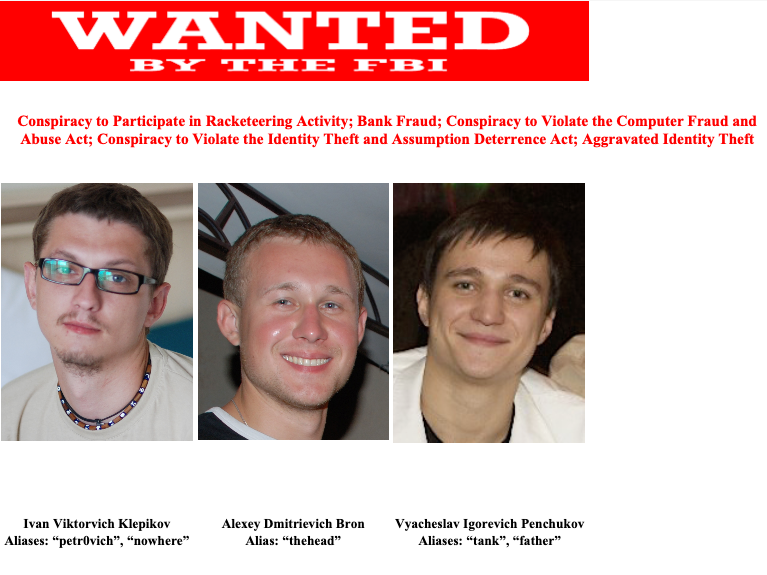
Wanted Ukrainian cybercrime suspect Vyacheslav “Tank” Penchukov (right) was arrested in Geneva, Switzerland. Tank was the day-to-day manager of a cybercriminal group that stole tens of millions of dollars from small to mid-sized businesses.
Penchukov was named in a 2014 indictment by the U.S. Department of Justice as a top figure in the JabberZeus Crew, a small but potent cybercriminal collective from Ukraine and Russia that attacked victim companies with a powerful, custom-made version of the Zeus banking trojan.
The U.S. Federal Bureau of Investigation (FBI) declined to comment for this story. But according to multiple sources, Penchukov was arrested in Geneva, Switzerland roughly three weeks ago as he was traveling to meet up with his wife there.
Penchukov is from Donetsk, a traditionally Russia-leaning region in Eastern Ukraine that was recently annexed by Russia. In his hometown, Penchukov was a well-known deejay (“DJ Slava Rich“) who enjoyed being seen riding around in his high-end BMWs and Porsches. More recently, Penchukov has been investing quite a bit in local businesses.
The JabberZeus crew’s name is derived from the malware they used, which was configured to send them a Jabber instant message each time a new victim entered a one-time password code into a phishing page mimicking their bank. The JabberZeus gang targeted mostly small to mid-sized businesses, and they were an early pioneer of so-called “man-in-the-browser” attacks, malware that can silently siphon any data that victims submit via a web-based form.
Once inside a victim company’s bank accounts, the crooks would modify the firm’s payroll to add dozens of “money mules,” people recruited through work-at-home schemes to handle bank transfers. The mules in turn would forward any stolen payroll deposits — minus their commissions — via wire transfer overseas.

Tank, a.k.a. “DJ Slava Rich,” seen here performing as a DJ in Ukraine in an undated photo from social media.
The JabberZeus malware was custom-made for the crime group by the alleged author of the Zeus trojan — Evgeniy Mikhailovich Bogachev, a top Russian cybercriminal with a $3 million bounty on his head from the FBI. Bogachev is accused of running the Gameover Zeus botnet, a massive crime machine of 500,000 to 1 million infected PCs that was used for large DDoS attacks and for spreading Cryptolocker — a peer-to-peer ransomware threat that was years ahead of its time.
Investigators knew Bogachev and JabberZeus were linked because for many years they were reading the private Jabber chats between and among members of the JabberZeus crew, and Bogachev’s monitored aliases were in semi-regular contact with the group about updates to the malware.
Gary Warner, director of research in computer forensics at the University of Alabama at Birmingham, noted in his blog from 2014 that Tank told co-conspirators in a JabberZeus chat on July 22, 2009 that his daughter, Miloslava, had been born and gave her birth weight.
“A search of Ukrainian birth records only showed one girl named Miloslava with that birth weight born on that day,” Warner wrote. This was enough to positively identify Tank as Penchukov, Warner said.
Ultimately, Penchukov’s political connections helped him evade prosecution by Ukrainian cybercrime investigators for many years. The late son of former Ukrainian President Victor Yanukovych (Victor Yanukovych Jr.) would serve as godfather to Tank’s daughter Miloslava. Through his connections to the Yanukovych family, Tank was able to establish contact with key insiders in top tiers of the Ukrainian government, including law enforcement.
Sources briefed on the investigation into Penchukov said that in 2010 — at a time when the Security Service of Ukraine (SBU) was preparing to serve search warrants on Tank and his crew — Tank received a tip that the SBU was coming to raid his home. That warning gave Tank ample time to destroy important evidence against the group, and to avoid being home when the raids happened. Those sources also said Tank used his contacts to have the investigation into his crew moved to a different unit that was headed by his corrupt SBU contact.
Writing for Technology Review, Patrick Howell O’Neil recounted how SBU agents in 2010 were trailing Tank around the city, watching closely as he moved between nightclubs and his apartment.
“In early October, the Ukrainian surveillance team said they’d lost him,” he wrote. “The Americans were unhappy, and a little surprised. But they were also resigned to what they saw as the realities of working in Ukraine. The country had a notorious corruption problem. The running joke was that it was easy to find the SBU’s anticorruption unit—just look for the parking lot full of BMWs.”
I first encountered Tank and the JabberZeus crew roughly 14 years ago as a reporter for The Washington Post, after a trusted source confided that he’d secretly gained access to the group’s private Jabber conversations.
From reading those discussions each day, it became clear Tank was nominally in charge of the Ukrainian crew, and that he spent much of his time overseeing the activities of the money mule recruiters — which were an integral part of their victim cashout scheme.
It was soon discovered that the phony corporate websites the money mule recruiters used to manage new hires had a security weakness that allowed anyone who signed up at the portal to view messages for every other user. A scraping tool was built to harvest these money mule recruitment messages, and at the height of the JabberZeus gang’s activity in 2010 that scraper was monitoring messages on close to a dozen different money mule recruitment sites, each managing hundreds of “employees.”
Each mule was given busy work or menial tasks for a few days or weeks prior to being asked to handle money transfers. I believe this was an effort to weed out unreliable money mules. After all, those who showed up late for work tended to cost the crooks a lot of money, as the victim’s bank would usually try to reverse any transfers that hadn’t already been withdrawn by the mules.
When it came time to transfer stolen funds, the recruiters would send a message through the fake company website saying something like: “Good morning [mule name here]. Our client — XYZ Corp. — is sending you some money today. Please visit your bank now and withdraw this payment in cash, and then wire the funds in equal payments — minus your commission — to these three individuals in Eastern Europe.”
Only, in every case the company mentioned as the “client” was in fact a small business whose payroll accounts they’d already hacked into.
So, each day for several years my morning routine went as follows: Make a pot of coffee; shuffle over to the computer and view the messages Tank and his co-conspirators had sent to their money mules over the previous 12-24 hours; look up the victim company names in Google; pick up the phone to warn each that they were in the process of being robbed by the Russian Cyber Mob.
My spiel on all of these calls was more or less the same: “You probably have no idea who I am, but here’s all my contact info and what I do. Your payroll accounts have been hacked, and you’re about to lose a great deal of money. You should contact your bank immediately and have them put a hold on any pending transfers before it’s too late. Feel free to call me back afterwards if you want more information about how I know all this, but for now please just call or visit your bank.”
In many instances, my call would come in just minutes or hours before an unauthorized payroll batch was processed by the victim company’s bank, and some of those notifications prevented what otherwise would have been enormous losses — often several times the amount of the organization’s normal weekly payroll. At some point I stopped counting how many tens of thousands of dollars those calls saved victims, but over several years it was probably in the millions.
Just as often, the victim company would suspect that I was somehow involved in the robbery, and soon after alerting them I would receive a call from an FBI agent or from a police officer in the victim’s hometown. Those were always interesting conversations.
Collectively, these notifications to victims led to dozens of stories over several years about small businesses battling their financial institutions to recover their losses. I never wrote about a single victim that wasn’t okay with my calling attention to their plight and to the sophistication of the threat facing other companies.
This incessant meddling on my part very much aggravated Tank, who on more than one occasion expressed mystification as to how I knew so much about their operations and victims. Here’s a snippet from one of their Jabber chats in 2009, after I’d written a story for The Washington Post about their efforts to steal $415,000 from the coffers of Bullitt County, Kentucky. In the chat below, “lucky12345” is the Zeus author Bogachev:
tank: Are you there?
tank: This is what they damn wrote about me.
tank: http://voices.washingtonpost.com/securityfix/2009/07/an_odyssey_of_fraud_part_ii.html#more
tank: I’ll take a quick look at history
tank: Originator: BULLITT COUNTY FISCAL Company: Bullitt County Fiscal Court
tank: Well, you got [it] from that cash-in.
lucky12345: From 200K?
tank: Well, they are not the right amounts and the cash out from that account was shitty.
tank: Levak was written there.
tank: Because now the entire USA knows about Zeus.
tank:
lucky12345: It’s fucked.
On Dec. 13, 2009, one of Tank’s top money mule recruiters — a crook who used the pseudonym “Jim Rogers” — told his boss something I hadn’t shared beyond a few trusted confidants at that point: That The Washington Post had eliminated my job in the process of merging the newspaper’s Web site (where I worked at the time) with the dead tree edition.
jim_rogers: There is a rumor that our favorite (Brian) didn’t get his contract extension at Washington Post. We are giddily awaiting confirmation
Good news expected exactly by the New Year! Besides us no one reads his column
tank: Mr. Fucking Brian Fucking Kerbs!
Another member of the JabberZeus crew — Ukrainian-born Maksim “Aqua” Yakubets — also is currently wanted by the FBI, which is offering a $5 million reward for information leading to his arrest and conviction.
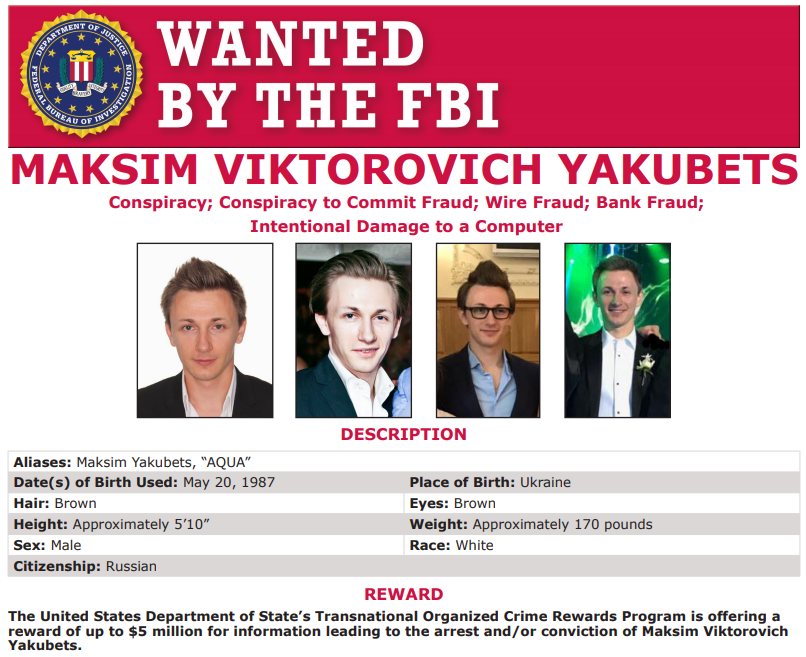
Alleged “Evil Corp” bigwig Maksim “Aqua” Yakubets. Image: FBI
Update, Nov. 16, 2022, 7:55 p.m. ET:: Multiple media outlets are reporting that Swiss authorities confirmed they arrested a Ukrainian national wanted on cybercrime charges. The arrest occurred in Geneva on Oct. 23, 2022. “The US authorities accuse the prosecuted person of extortion, bank fraud and identity theft, among other things,” reads a statement from the Swiss Federal Office of Justice (FOJ).
“During the hearing on 24 October, 2022, the person did not consent to his extradition to the USA via a simplified proceeding,” the FOJ continued. “After completion of the formal extradition procedure, the FOJ has decided to grant his extradition to the USA on 15 November, 2022. The decision of the FOJ may be appealed at the Swiss Criminal Federal Court, respectively at the Swiss Supreme Court.”
A nonprofit organization is suing the state of Massachusetts on behalf of thousands of low-income families who were collectively robbed of more than a $1 million in food assistance benefits by card skimming devices secretly installed at cash machines and grocery store checkout lanes across the state. Federal law bars states from replacing these benefits using federal funds, and a recent rash of skimming incidents nationwide has disproportionately affected those receiving food assistance via state-issued prepaid debit cards.

The Massachusetts SNAP benefits card looks more like a library card than a payment card.
On Nov. 4, The Massachusetts Law Reform Institute (MLRI) filed a class action lawsuit on behalf of low-income families whose Supplemental Nutrition and Assistance Program (SNAP) benefits were stolen from their accounts. The SNAP program serves over a million people in Massachusetts, and 41 million people nationally.
“Over the past few months, thieves have stolen over a million SNAP dollars from thousands of Massachusetts families – putting their nutrition and economic stability at risk,” the MLRI said in a statement on the lawsuit. “The criminals attach a skimming device on a POS (point of sale) terminal to capture the household’s account information and PIN. The criminals then use that information to make a fake card and steal the SNAP benefits.”
In announcing the lawsuit, the MRLI linked to a story KrebsOnSecurity published last month that examined how skimming thieves increasingly are targeting SNAP payment card holders nationwide. The story looked at how the vast majority of SNAP benefit cards issued by the states do not include the latest chip technology that makes it more difficult and expensive for thieves to clone them.
The story also highlighted how SNAP cardholders usually have little recourse to recover any stolen funds — even in unlikely cases where the victim has gathered mountains of proof to show state and federal officials that the fraudulent withdrawals were not theirs.
Deborah Harris is a staff attorney at the MLRI. Harris said the goal of the lawsuit is to force Massachusetts to reimburse SNAP skimming victims using state funds, and to convince The U.S. Department of Agriculture (USDA) — which funds the program that states draw from — to change its policies and allow states to replace stolen benefits with federal funds.
“Ultimately we think it’s the USDA that needs to step up and tell states they have a duty to restore the stolen benefits, and that USDA will cover the cost at least until there is better security in place, such as chip cards,” Harris told KrebsOnSecurity.
“The losses we’re talking about are relatively small in the scheme of total SNAP expenditures which are billions,” she said. “But if you are a family that can’t pay for food because you suddenly don’t have money in your account, it’s devastating for the family.”
The USDA has not said it will help states restore the stolen funds. But on Oct. 31, 2022, the agency released guidance (PDF) whose primary instructions were included in an appendix titled, Card Security Options Available to Households. Notably, the USDA did not mention the idea of shifting to chip-based SNAP benefits cards.

The recently issued USDA guidance.
“The guidance generally continues to make households responsible for preventing the theft of their benefits as well as for suffering the loss when benefits are stolen through no fault of the household,” Harris said. “Many of the recommendations are not practical for households who don’t have a smartphone to receive text messages and aren’t able to change their PIN after each transaction and keep track of the new PIN.”
Harris said three of the four recommendations are not currently available in Massachusetts, and they are very likely not currently available in other states. For example, she said, Massachusetts households do not have the option of freezing or locking their cards between transactions. Nor do they receive alerts about transactions. And they most certainly don’t have any way to block out-of-state transactions.
“Perhaps these are options that [card] processors and states could provide, but they are not available now as far as we know,” Harris said. “Most likely they would take time to implement.”
The Center for Law and Social Policy (CLASP) recently published Five Ways State Agencies Can Support EBT Users at Risk of Skimming. CLASP says while it is true states can’t use federal funds to replace benefits unless the loss was due to a “system error,” states could use their own funds.
“Doing so will ensure families don’t have to go without food, gas money, or their rent for the month,” CLASP wrote.
That would help address the symptoms of card skimming, but not a root cause. Hardly anyone is suggesting the obvious, which is to equip SNAP benefit cards with the same security technology afforded to practically everyone else participating in the U.S. banking system.
There are several reasons most state-issued SNAP benefit cards do not include chips. For starters, nobody says they have to. Also, it’s a fair bit more expensive to produce chip cards versus plain old magnetic stripe cards, and many state assistance programs are chronically under-funded. Finally, there is no vocal (or at least well-heeled) constituency advocating for change.
A copy of the class action complaint filed by the MLRI is available here.
Let’s face it: Having “2022 election” in the headline above is probably the only reason anyone might read this story today. Still, while most of us here in the United States are anxiously awaiting the results of how well we’ve patched our Democracy, it seems fitting that Microsoft Corp. today released gobs of security patches for its ubiquitous Windows operating systems. November’s patch batch includes fixes for a whopping six zero-day security vulnerabilities that miscreants and malware are already exploiting in the wild.

Probably the scariest of the zero-day flaws is CVE-2022-41128, a “critical” weakness in the Windows scripting languages that could be used to foist malicious software on vulnerable users who do nothing more than browse to a hacked or malicious site that exploits the weakness. Microsoft credits Google with reporting the vulnerability, which earned a CVSS score of 8.8.
CVE-2022-41073 is a zero-day flaw in the Windows Print Spooler, a Windows component that Microsoft has patched mightily over the past year. Kevin Breen, director of cyber threat research at Immersive Labs, noted that the print spooler has been a popular target for vulnerabilities in the last 12 months, with this marking the 9th patch.
The third zero-day Microsoft patched this month is CVE-2022-41125, which is an “elevation of privilege” vulnerability in the Windows Cryptography API: Next Generation (CNG) Key Isolation Service, a service for isolating private keys. Satnam Narang, senior staff research engineer at Tenable, said exploitation of this vulnerability could grant an attacker SYSTEM privileges.
The fourth zero-day, CVE-2022-41091, was previously disclosed and widely reported on in October. It is a Security Feature Bypass of “Windows Mark of the Web” – a mechanism meant to flag files that have come from an untrusted source.
The other two zero-day bugs Microsoft patched this month were for vulnerabilities being exploited in Exchange Server. News that these two Exchange flaws were being exploited in the wild surfaced in late September 2022, and many were surprised when Microsoft let October’s Patch Tuesday sail by without issuing official patches for them (the company instead issued mitigation instructions that it was forced to revise multiple times). Today’s patch batch addresses both issues.
Greg Wiseman, product manager at Rapid7, said the Exchange flaw CVE-2022-41040 is a “critical” elevation of privilege vulnerability, and CVE-2022-41082 is considered Important, allowing Remote Code Execution (RCE) when PowerShell is accessible to the attacker.
“Both vulnerabilities have been exploited in the wild,” Wiseman said. “Four other CVEs affecting Exchange Server have also been addressed this month. Three are rated as Important, and CVE-2022-41080 is another privilege escalation vulnerability considered Critical. Customers are advised to update their Exchange Server systems immediately, regardless of whether any previously recommended mitigation steps have been applied. The mitigation rules are no longer recommended once systems have been patched.”
Adobe usually issues security updates for its products on Patch Tuesday, but it did not this month. For a closer look at the patches released by Microsoft today and indexed by severity and other metrics, check out the always-useful Patch Tuesday roundup from the SANS Internet Storm Center. And it’s not a bad idea to hold off updating for a few days until Microsoft works out any kinks in the updates: AskWoody.com usually has the lowdown on any patches that may be causing problems for Windows users.
As always, please consider backing up your system or at least your important documents and data before applying system updates. And if you run into any problems with these updates, please drop a note about it here in the comments.
Responding to a recent surge in AI-generated bot accounts, LinkedIn is rolling out new features that it hopes will help users make more informed decisions about with whom they choose to connect. Many LinkedIn profiles now display a creation date, and the company is expanding its domain validation offering, which allows users to publicly confirm that they can reply to emails at the domain of their stated current employer.
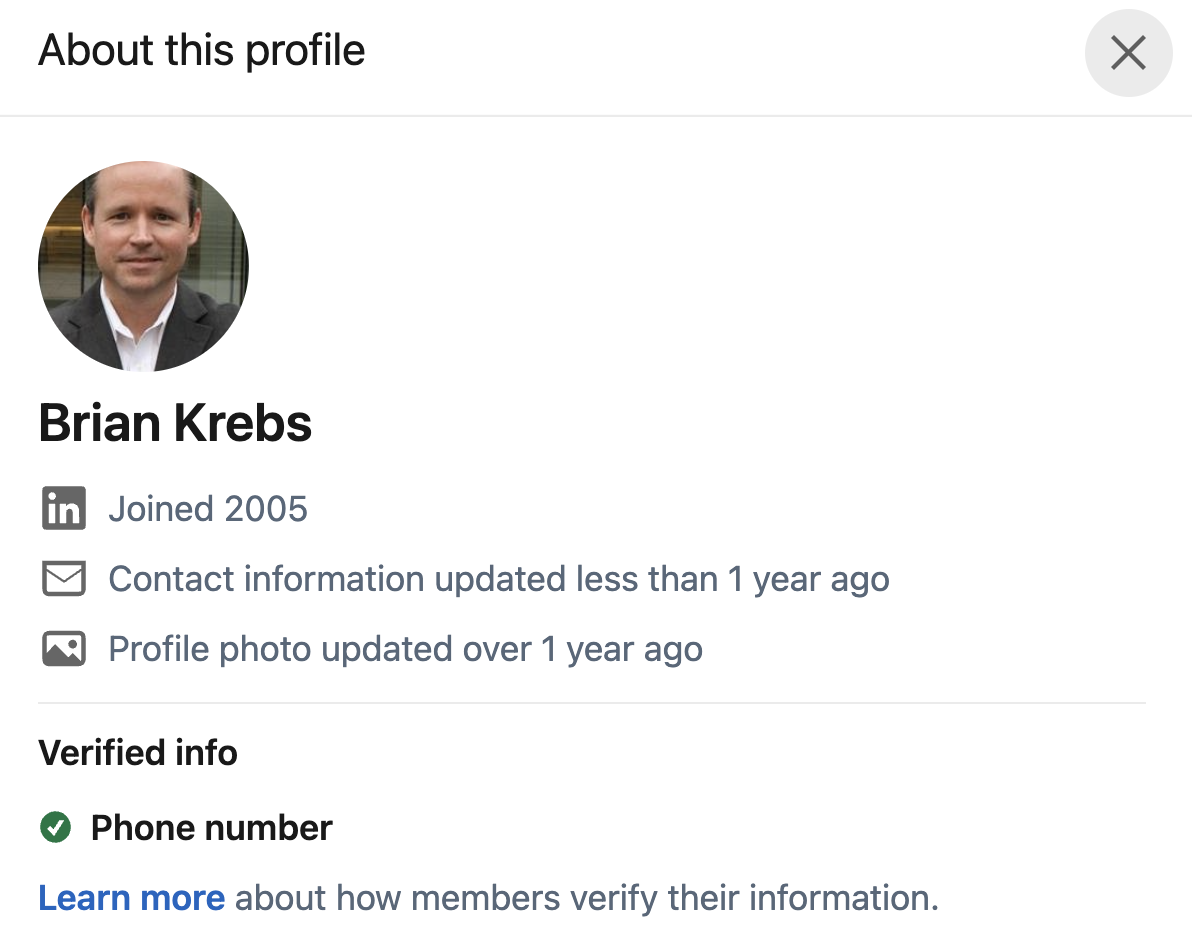
LinkedIn’s new “About This Profile” section — which is visible by clicking the “More” button at the top of a profile — includes the year the account was created, the last time the profile information was updated, and an indication of how and whether an account has been verified.
LinkedIn also said it is adding a warning to some LinkedIn messages that include high-risk content, or that try to entice the user into taking the conversation to another platform (like WeChat).
“We may warn you about messages that ask you to take the conversation to another platform because that can be a sign of a scam,” the company said in a blog post. “These warnings will also give you the choice to report the content without letting the sender know.”
In late September 2022, KrebsOnSecurity warned about the proliferation of fake LinkedIn profiles for Chief Information Security Officer (CISO) roles at some of the world’s largest corporations. A follow-up story on Oct. 5 showed how the phony profile problem has affected virtually all executive roles at corporations, and how these fake profiles are creating an identity crisis for the businesses networking site and the companies that rely on it to hire and screen prospective employees.
Reporting here last month also tracked a massive drop in profiles claiming to work at several major technology companies, as LinkedIn apparently took action against hundreds of thousands of inauthentic accounts that falsely claimed roles at these companies.
For example, on October 10, 2022, there were 576,562 LinkedIn accounts that listed their current employer as Apple Inc. The next day, half of those profiles no longer existed. At around the same time, the number of LinkedIn profiles claiming current roles at Amazon fell from roughly 1.25 million to 838,601 in just one day, a 33 percent drop.
For whatever reason, the majority of the phony LinkedIn profiles reviewed by this author were young women with profile photos that appear to have been generated by artificial intelligence (AI) tools.
“We’re seeing rapid advances in AI-based synthetic image generation technology and we’ve created a deep learning model to better catch profiles made with this technology,” LinkedIn’s Oscar Rodriguez wrote. “AI-based image generators can create an unlimited number of unique, high-quality profile photos that do not correspond to real people.”
It remains unclear who or what is behind the recent proliferation of fake executive profiles on LinkedIn, but likely they are from a combination of scams. Cybersecurity firm Mandiant (recently acquired by Google) told Bloomberg that hackers working for the North Korean government have been copying resumes and profiles from leading job listing platforms LinkedIn and Indeed, as part of an elaborate scheme to land jobs at cryptocurrency firms.
Identity thieves have been known to masquerade on LinkedIn as job recruiters, collecting personal and financial information from people who fall for employment scams.
Also, fake profiles also may be tied to so-called “pig butchering” scams, wherein people are lured by flirtatious strangers online into investing in cryptocurrency trading platforms that eventually seize any funds when victims try to cash out.

A 25-year-old Finnish man has been charged with extorting a once popular and now-bankrupt online psychotherapy company and its patients. Finnish authorities rarely name suspects in an investigation, but they were willing to make an exception for Julius “Zeekill” Kivimaki, a notorious hacker who — at the tender age of 17 — had been convicted of more than 50,000 cybercrimes, including data breaches, payment fraud, operating botnets, and calling in bomb threats.
In late October 2022, Kivimaki was charged (and arrested in absentia, according to the Finns) with attempting to extort money from the Vastaamo Psychotherapy Center. On October 21, 2020, Vastaamo became the target of blackmail when a tormentor identified as “ransom_man” demanded payment of 40 bitcoins (~450,000 euros at the time) in return for a promise not to publish highly sensitive therapy session notes Vastaamo had exposed online.
In a series of posts over the ensuing days on a Finnish-language dark net discussion board, ransom_man said Vastaamo appeared unwilling to negotiate a payment, and that he would start publishing 100 patient profiles every 24 hours “to provide further incentive for the company to continue communicating with us.”
“We’re not asking for much, approximately 450,000 euros which is less than 10 euros per patient and only a small fraction of the around 20 million yearly revenues of this company,” ransom_man wrote.
When Vastaamo declined to pay, ransom_man shifted to extorting individual patients. According to Finnish police, some 22,000 victims reported extortion attempts targeting them personally, targeted emails that threatened to publish their therapy notes online unless paid a 500 euro ransom.

The extortion message targeted Vastaamo patients.
On Oct. 23, 2020, ransom_man uploaded to the dark web a large compressed file that included all of the stolen Vastaamo patient records. But investigators found the file also contained an entire copy of ransom_man’s home folder, a likely mistake that exposed a number of clues that they say point to Kivimaki.
Ransom_man quickly deleted the large file (accompanied by a “whoops” notation), but not before it had been downloaded a number of times. The entire archive has since been made into a searchable website on the Dark Web.
Among those who grabbed a copy of the database was Antti Kurittu, a team lead at Nixu Corporation and a former criminal investigator. In 2013, Kurittu worked on investigation involving Kivimaki’s use of the Zbot botnet, among other activities Kivimaki engaged in as a member of the hacker group Hack the Planet.
“It was a huge opsec [operational security] fail, because they had a lot of stuff in there — including the user’s private SSH folder, and a lot of known hosts that we could take a very good look at,” Kurittu told KrebsOnSecurity, declining to discuss specifics of the evidence investigators seized. “There were also other projects and databases.”
Kurittu said he and others he and others who were familiar with illegal activities attributed to Kivimäki couldn’t shake suspicion that the infamous cybercriminal was also behind the Vastaamo extortion.
“I couldn’t find anything that would link that data directly to one individual, but there were enough indicators in there that put the name in my head and I couldn’t shake it,” Kurittu said. “When they named him as the prime suspect I was not surprised.”
A handful of individually extorted victims paid a ransom, but when news broke that the entire Vastaamo database had been leaked online, the extortion threats no longer held their sting. However, someone would soon set up a site on the dark web where anyone could search this sensitive data.
Kivimaki stopped using his middle name Julius in favor of his given first name Aleksanteri when he moved abroad several years ago. A Twitter account by that name was verified by Kivimaki’s attorney as his, and through that account he denied being involved in the Vastaamo extortion.
“I believe [the Finnish authorities] brought this to the public in order to influence the decision-making of my old case from my teenage years, which was just processed in the Court of Appeal, both cases are investigated by the same persons,” Kivimaki tweeted on Oct. 28.
Kivimaki is appealing a 2020 district court decision sentencing him to “one year of conditional imprisonment for two counts of fraud committed as a young person, and one of gross fraud, interference with telecommunications as a young person, aggravated data breach as a young person and incitement to fraud as a young person,” according to the Finnish tabloid Ilta-Sanomat.
“Now in the Court of Appeal, the prosecutor is demanding a harsher punishment for the man, i.e. unconditional imprisonment,” reads the Ilta-Sanomat story. “The prosecutor notes in his complaint that the young man has been committing cybercrimes from Espoo since he was 15 years old, and the actions have had to be painstakingly investigated through international legal aid.”
As described in this Wired story last year, Vastaamo filled an urgent demand for psychological counseling, and it won accolades from Finnish health authorities and others for its services.
“Vastaamo was a private company, but it seemed to operate in the same spirit of tech-enabled ease and accessibility: You booked a therapist with a few clicks, wait times were tolerable, and Finland’s Social Insurance Institution reimbursed a big chunk of the session fee (provided you had a diagnosed mental disorder),” William Ralston wrote for Wired. “The company was run by Ville Tapio, a 39-year-old coder and entrepreneur with sharp eyebrows, slicked-back brown hair, and a heavy jawline. He’d cofounded the company with his parents. They pitched Vastaamo as a humble family-run enterprise committed to improving the mental health of all Finns.”
But for all the good it brought, the healthcare records management system that Vastaamo used relied on little more than a MySQL database that was left dangerously exposed to the web for 16 months, guarded by nothing more than an administrator account with a blank password.
The Finnish daily Iltalehti said Tapio was relieved of his duties as CEO of Vastaamo in October 2020, and that in September, prosecutors brought charges against Tapio for a data protection offense in connection with Vastaamo’s information leak.
“According to Vastaamo, the data breach in Vastaamo’s customer databases took place in November 2018,” Iltalehti reported last month. “According to Vastaamo, Tapio concealed information about the data breach for more than a year and a half.”
A 26-year-old Ukrainian man is awaiting extradition from The Netherlands to the United States on charges that he acted as a core developer for Raccoon, a popular “malware-as-a-service” offering that helped paying customers steal passwords and financial data from millions of cybercrime victims. KrebsOnSecurity has learned that the defendant was busted in March 2022, after fleeing mandatory military service in Ukraine in the weeks following the Russian invasion.

Ukrainian national Mark Sokolovsky, seen here in a Porsche Cayenne on Mar. 18 fleeing mandatory military service in Ukraine. This image was taken by Polish border authorities as Sokolovsky’s vehicle entered Germany. Image: KrebsOnSecurity.com.
The U.S. Attorney for the Western District of Texas unsealed an indictment last week that named Ukrainian national Mark Sokolovsky as the core developer for the Raccoon Infostealer business, which was marketed on several Russian-language cybercrime forums beginning in 2019.
Raccoon was essentially a Web-based control panel, where — for $200 a month — customers could get the latest version of the Raccoon Infostealer malware, and interact with infected systems in real time. Security experts say the passwords and other data stolen by Raccoon malware were often resold to groups engaged in deploying ransomware.
Working with investigators in Italy and The Netherlands, U.S. authorities seized a copy of the server used by Raccoon to help customers manage their botnets. According to the U.S. Justice Department, FBI agents have identified more than 50 million unique credentials and forms of identification (email addresses, bank accounts, cryptocurrency addresses, credit card numbers, etc.) stolen with the help of Raccoon.
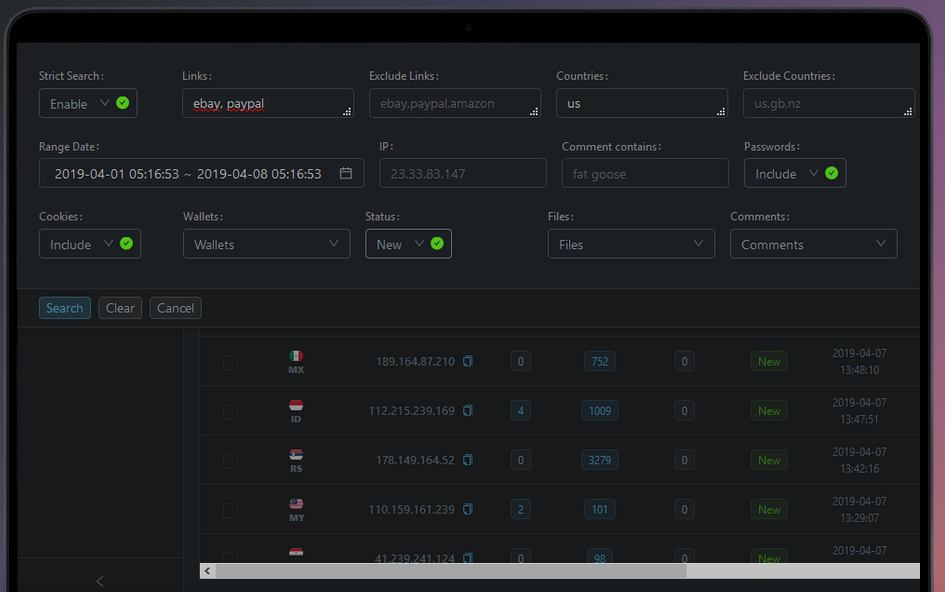
The Raccoon v. 1 web panel, where customers could search by infected IP, and stolen cookies, wallets, domains and passwords.
The unsealed indictment (PDF) doesn’t delve much into how investigators tied Sokolovsky to Raccoon, but two sources close to the investigation shared more information about that process on condition of anonymity because they were not authorized to discuss the case publicly.
According to those sources, U.S. authorities zeroed in on an operational security mistake that the Raccoon developer made early on in his posts to the crime forums, connecting a Gmail account for a cybercrime forum identity used by the Raccoon developer (“Photix”) to an Apple iCloud account belonging to Sokolovsky. For example, the indictment includes a photo that investigators subpoenaed from Sokolovsky’s iCloud account that shows him posing with several stacks of bundled cash.

A selfie pulled from Mark Sokolovsky’s iCloud account. Image: USDOJ.
When Russia invaded Ukraine in late February 2022, Sokolovsky was living in Kharkiv, a city in northeast Ukraine that would soon come under heavy artillery bombardment from Russian forces. Authorities monitoring Sokolovsky’s iCloud account had spent weeks watching him shuttle between Kharkiv and the Ukrainian capital Kyiv, but on Mar. 18, 2022, his phone suddenly showed up in Poland.
Investigators learned from Polish border guards that Sokolovsky had fled Ukraine in a Porsche Cayenne along with a young blond woman, leaving his mother and other family behind. The image at the top of this post was shared with U.S. investigators by Polish border security officials, and it shows Sokolovsky leaving Poland for Germany on Mar. 18.
At the time, all able-bodied men of military age were required to report for service to help repel the Russian invasion, and it would have been illegal for Sokolovsky to leave Ukraine without permission. But both sources said investigators believe Sokolovsky bribed border guards to let them pass.
Authorities soon tracked Sokolovsky’s phone through Germany and eventually to The Netherlands, with his female companion helpfully documenting every step of the trip on her Instagram account. Here is a picture she posted of the two embracing upon their arrival in Amsterdam’s Dam Square:

Authorities in The Netherlands arrested Sokolovsky on Mar. 20, and quickly seized control over the Raccoon Infostealer infrastructure. Meanwhile, on March 25 the accounts that had previously advertised the Raccoon Stealer malware on cybercrime forums announced the service was closing down. The parting message to customers said nothing of an arrest, and instead insinuated that the core members in charge of the malware-as-a-service project had perished in the Russian invasion.
“Unfortunately, due to the ‘special operation,’ we will have to close our Raccoon Stealer project,” the team announced Mar. 25. “Our team members who were responsible for critical components of the product are no longer with us. Thank you for this experience and time, for every day, unfortunately everything, sooner or later, the end of the WORLD comes to everyone.”
Sokolovsky’s extradition to the United States has been granted, but he is appealing that decision. He faces one count of conspiracy to commit computer fraud; one count of conspiracy to commit wire fraud; one count of conspiracy to commit money laundering, and one count of aggravated identity theft.
Sources tell KrebsOnSecurity that Sokolovsky has been consulting with Houston, Tx.-based attorney F. Andino Reynal, the same lawyer who represented Alex Jones in the recent defamation lawsuit against Jones and his conspiracy theory website Infowars. Reynal was responsible for what Jones himself referred to as the “Perry Mason” moment of the trial, wherein the plaintiff’s lawyer revealed that Reynal had inadvertently given them an entire digital copy of Jones’s cell phone. Mr. Reynal did not respond to requests for comment.
If convicted, Sokolovsky faces a maximum penalty of 20 years in prison for the wire fraud and money laundering offenses, five years for the conspiracy to commit computer fraud charge, and a mandatory consecutive two-year term for the aggravated identity theft offense.
The Justice Department has set up a website — raccoon.ic3.gov — that allows visitors to check whether their email address shows up in the data collected by the Raccoon Stealer service.

On October 10, 2022, there were 576,562 LinkedIn accounts that listed their current employer as Apple Inc. The next day, half of those profiles no longer existed. A similarly dramatic drop in the number of LinkedIn profiles claiming employment at Amazon comes as LinkedIn is struggling to combat a significant uptick in the creation of fake employee accounts that pair AI-generated profile photos with text lifted from legitimate users.
Jay Pinho is a developer who is working on a product that tracks company data, including hiring. Pinho has been using LinkedIn to monitor daily employee headcounts at several dozen large organizations, and last week he noticed that two of them had far fewer people claiming to work for them than they did just 24 hours previously.
Pinho’s screenshot below shows the daily count of employees as displayed on Amazon’s LinkedIn homepage. Pinho said his scraper shows that the number of LinkedIn profiles claiming current roles at Amazon fell from roughly 1.25 million to 838,601 in just one day, a 33 percent drop:

The number of LinkedIn profiles claiming current positions at Amazon fell 33 percent overnight. Image: twitter.com/jaypinho
As stated above, the number of LinkedIn profiles that claimed to work at Apple fell by approximately 50 percent on Oct. 10, according to Pinho’s analysis:
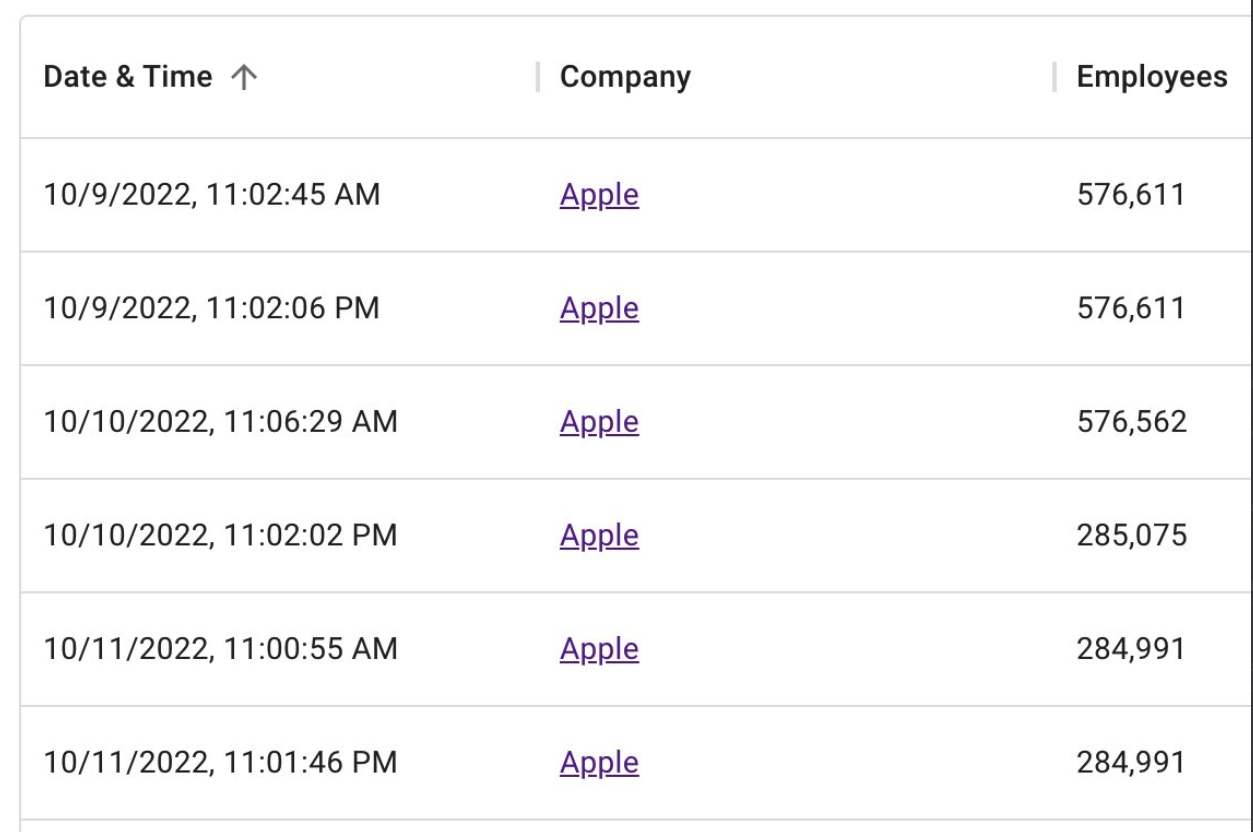
Image: twitter.com/jaypinho
Neither Amazon or Apple responded to requests for comment. LinkedIn declined to answer questions about the account purges, saying only that the company is constantly working to keep the platform free of fake accounts. In June, LinkedIn acknowledged it was seeing a rise in fraudulent activity happening on the platform.
KrebsOnSecurity hired Menlo Park, Calif.-based SignalHire to check Pinho’s numbers. SignalHire keeps track of active and former profiles on LinkedIn, and during the Oct 9-11 timeframe SignalHire said it saw somewhat smaller but still unprecedented drops in active profiles tied to Amazon and Apple.
“The drop in the percentage of 7-10 percent [of all profiles], as it happened [during] this time, is not something that happened before,” SignalHire’s Anastacia Brown told KrebsOnSecurity.
Brown said the normal daily variation in profile numbers for these companies is plus or minus one percent.
“That’s definitely the first huge drop that happened throughout the time we’ve collected the profiles,” she said.
In late September 2022, KrebsOnSecurity warned about the proliferation of fake LinkedIn profiles for Chief Information Security Officer (CISO) roles at some of the world’s largest corporations. A follow-up story on Oct. 5 showed how the phony profile problem has affected virtually all executive roles at corporations, and how these fake profiles are creating an identity crisis for the businesses networking site and the companies that rely on it to hire and screen prospective employees.
A day after that second story ran, KrebsOnSecurity heard from a recruiter who noticed the number of LinkedIn profiles that claimed virtually any role in network security had dropped seven percent overnight. LinkedIn declined to comment about that earlier account purge, saying only that, “We’re constantly working at taking down fake accounts.”

A “swarm” of LinkedIn AI-generated bot accounts flagged by a LinkedIn group administrator recently.
It’s unclear whether LinkedIn is responsible for this latest account purge, or if individually affected companies are starting to take action on their own. The timing, however, argues for the former, as the account purges for Apple and Amazon employees tracked by Pinho appeared to happen within the same 24 hour period.
It’s also unclear who or what is behind the recent proliferation of fake executive profiles on LinkedIn. Cybersecurity firm Mandiant (recently acquired by Google) told Bloomberg that hackers working for the North Korean government have been copying resumes and profiles from leading job listing platforms LinkedIn and Indeed, as part of an elaborate scheme to land jobs at cryptocurrency firms.
On this point, Pinho said he noticed an account purge in early September that targeted fake profiles tied to jobs at cryptocurrency exchange Binance. Up until Sept. 3, there were 7,846 profiles claiming current executive roles at Binance. The next day, that number stood at 6,102, a 23 percent drop (by some accounts that 6,102 head count is still wildly inflated).

Fake profiles also may be tied to so-called “pig butchering” scams, wherein people are lured by flirtatious strangers online into investing in cryptocurrency trading platforms that eventually seize any funds when victims try to cash out.
In addition, identity thieves have been known to masquerade on LinkedIn as job recruiters, collecting personal and financial information from people who fall for employment scams.
Nicholas Weaver, a researcher for the International Computer Science Institute at University of California, Berkeley, suggested another explanation for the recent glut of phony LinkedIn profiles: Someone may be setting up a mass network of accounts in order to more fully scrape profile information from the entire platform.
“Even with just a standard LinkedIn account, there’s a pretty good amount of profile information just in the default two-hop networks,” Weaver said. “We don’t know the purpose of these bots, but we know creating bots isn’t free and creating hundreds of thousands of bots would require a lot of resources.”
In response to last week’s story about the explosion of phony accounts on LinkedIn, the company said it was exploring new ways to protect members, such as expanding email domain verification. Under such a scheme, LinkedIn users would be able to publicly attest that their profile is accurate by verifying that they can respond to email at the domain associated with their current employer.
LinkedIn claims that its security systems detect and block approximately 96 percent of fake accounts. And despite the recent purges, LinkedIn may be telling the truth, Weaver said.
“There’s no way you can test for that,” he said. “Because technically, it may be that there were actually 100 million bots trying to sign up at LinkedIn as employees at Amazon.”
Weaver said the apparent mass account purge at LinkedIn underscores the size of the bot problem, and could present a “real and material change” for LinkedIn.
“It may mean the statistics they’ve been reporting about usage and active accounts are off by quite a bit,” Weaver said.
When people banking in the United States lose money because their payment card got skimmed at an ATM, gas pump or grocery store checkout terminal, they may face hassles or delays in recovering any lost funds, but they are almost always made whole by their financial institution. Yet, one class of Americans — those receiving food assistance benefits via state-issued prepaid debit cards — are particularly exposed to losses from skimming scams, and usually have little recourse to do anything about it.

California’s EBT card does not currently include a chip. That silver square is a hologram.
Over the past several months, authorities in multiple U.S. states have reported rapid increases in skimming losses tied to people who receive assistance via Electronic Benefits Transfer (EBT), which allows a Supplemental Nutrition Assistance Program (SNAP) participant to pay for food using SNAP benefits.
When a participant uses a SNAP payment card at an authorized retail store, their SNAP EBT account is debited to reimburse the store for food that was purchased. EBT is used in all 50 states, the District of Columbia, Puerto Rico, the Virgin Islands, and Guam.
EBT cards work just like regular debit cards, in that they can be used along with a personal identification number (PIN) to pay for goods at participating stores, and to withdraw cash from an ATM.
However, EBT cards differ from debit cards issued to most Americans in two important ways. First, most states do not equip EBT cards with smart chip technology, which can make payment cards much more difficult and expensive for skimming thieves to clone.
Alas, it is no accident that all of the states reporting recent spikes in fraud tied to EBT accounts — including California, Connecticut, Maryland, Pennsylvania, Tennessee, and Virginia appear to currently issue chip-less cards to their EBT recipients.

The Massachusetts SNAP benefits card looks more like a library card than a payment card. Oddly enough, both are reliant on the same fundamentally insecure technology: The magnetic stripe, which stores cardholder data in plain text that can be easily copied.
In September, authorities in California arrested three men thought to be part of a skimming crew that specifically targeted EBT cards and balances. The men allegedly installed deep insert skimmers, and stole PINs using tiny hidden cameras.
“The arrests were the result of a joint investigation by the Sheriff’s Office and Bank of America corporate security,” reads a September 2022 story from The Sacramento Bee. “The investigation focused on illegal skimming, particularly the high-volume cash-out sequence at ATMs near the start of each month when Electronic Benefits Transfer accounts are funded by California.”
Armed with a victim’s PIN along with stolen card data, thieves can clone the card onto anything with a magnetic stripe and use it at ATMs to withdraw cash, or as a payment instrument at any establishment that accepts EBT cards.
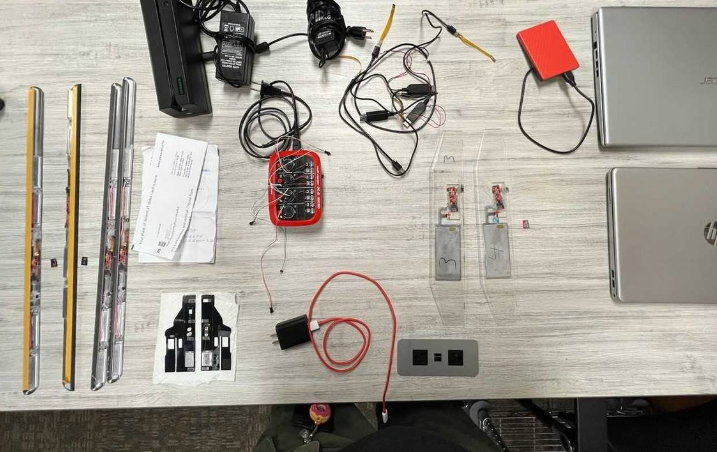
Skimming gear seized from three suspects arrested by Sacramento authorities in September. Image: Sacramento County Sheriff’s Office.
Although it may be shocking that California — one of America’s wealthiest states — still treats EBT recipients as second-class citizens by issuing them chip-less debit cards, California behaves like most other states in this regard.
More critical, however, is the second way SNAP cards differ from regular debit cards: Recipients of SNAP benefits have little to no hope of recovering their funds when their EBT cards are copied by card-skimming devices and used for fraud.
That’s because in the SNAP program, federal law bars the states from replacing SNAP benefits using federal funds. And while some of these EBT cards have Visa or MasterCard logos on them, it is not up to those companies to replace funds in the event of fraud.
Victims are encouraged to report the theft to both their state agency and the local police, but many victims say they rarely receive updates on their cases from police, and, if they hear from the state, it’s usually the agency telling them it found no evidence of fraud.

Maryland’s EBT card.
That’s according to Brenna Smith, a reporter at The Baltimore Banner who recently wrote about the case of a Maryland mother of three who lost nearly $3,000 in SNAP benefits thanks to a skimmer installed at a local 7-Eleven. Maryland [Department of Human Services] spokesperson Katherine Morris told the Banner there was evidence of “a nationwide EBT card cloning scheme.”
The woman profiled in Smith’s story contacted all of the retailers where her EBT card was used to buy thousands of dollars worth of baby formula. Two of those retailers agreed to share video surveillance footage of the people making the purchases at the exact timestamps specified in her EBT account history: The videos clearly showed it was the same fraudster making both purchases with a cloned copy of her EBT card.
Even after the police officer assigned to the victim’s case confirmed they found a skimmer installed at the 7-Eleven store she frequented, her claim — which was denied — is still languishing in appeals months later.

(Left) A video still showing a couple purchasing almost $1,200 in baby formula using SNAP benefits. (Right) A video still of a woman leaving from the CVS in Seat Pleasant. Image: The Baltimore Banner.
The Center for Law and Social Policy (CLASP) recently published Five Ways State Agencies Can Support EBT Users at Risk of Skimming. CLASP says while it is true states can’t use federal funds to replace benefits unless the loss was due to a “system error,” states could use their own funds.
“Doing so will ensure families don’t have to go without food, gas money, or their rent for the month,” CLASP wrote.
That would help address the symptoms of card skimming, but not a root cause. Hardly anyone is suggesting the obvious, which is to equip EBT cards with the same security technology afforded to practically everyone else participating in the U.S. banking system.
There are several reasons most state-issued EBT cards do not include chips. For starters, nobody says they have to. Also, it’s a fair bit more expensive to produce chip cards versus plain old magnetic stripe cards, and many state assistance programs are chronically under-funded. Finally, there is no vocal (or at least well-heeled) constituency advocating for change.
AMLBot, a service that helps businesses avoid transacting with cryptocurrency wallets that have been sanctioned for cybercrime activity, said an investigation published by KrebsOnSecurity last year helped it shut down three dark web services that secretly resold its technology to help cybercrooks avoid detection by anti-money laundering systems.
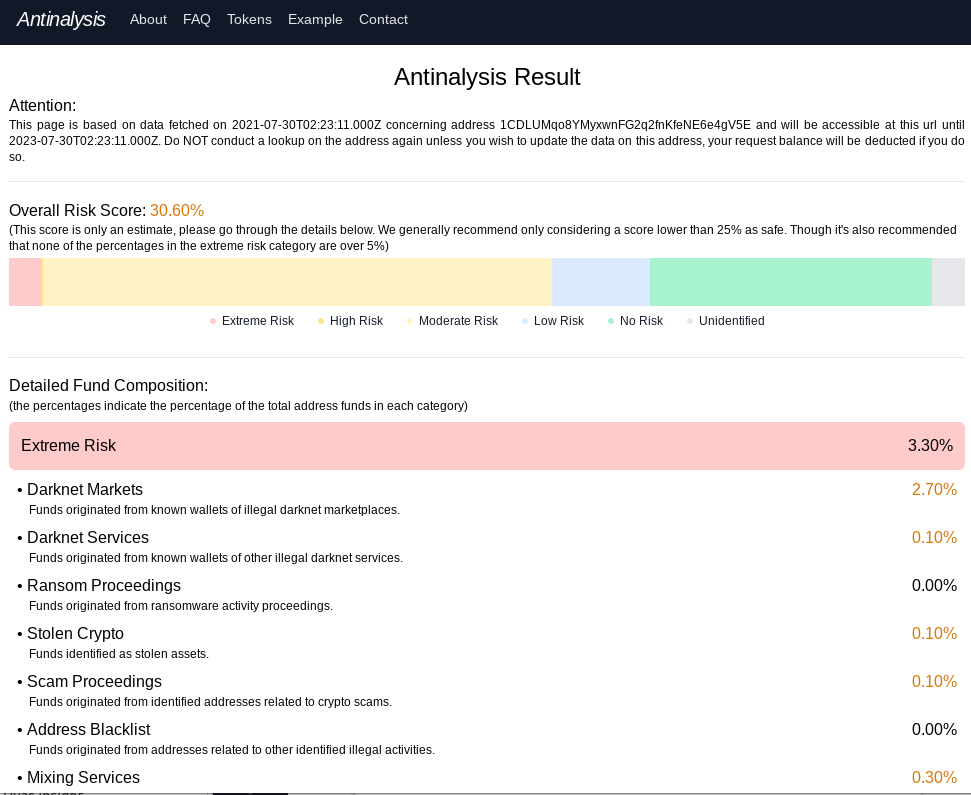
Antinalysis, as it existed in 2021.
In August 2021, KrebsOnSecurity published “New Anti Anti-Money Laundering Services for Crooks,” which examined Antinalysis, a service marketed on cybercrime forums that purported to offer a glimpse of how one’s payment activity might be flagged by law enforcement agencies and private companies that track and trace cryptocurrency transactions.
“Worried about dirty funds in your BTC address? Come check out Antinalysis, the new address risk analyzer,” read the service’s opening announcement. “This service is dedicated to individuals that have the need to possess complete privacy on the blockchain, offering a perspective from the opponent’s point of view in order for the user to comprehend the possibility of his/her funds getting flagged down under autocratic illegal charges.”
Antinalysis allows free lookups, but anyone wishing to conduct bulk look-ups has to pay at least USD $3, with a minimum $30 purchase. Other plans go for as high as $6,000 for 5,000 requests. Nick Bax, a security researcher who specializes in tracing cryptocurrency transactions, told KrebsOnSecurity at the time that Antinalysis was likely a clone of AMLBot because the two services generated near-identical results.
AMLBot shut down Antinalysis’s access just hours after last year’s story went live. However, Antinalysis[.]org remains online and accepting requests, as does the service’s Tor-based domain, and it is unclear how those services are sourcing their information.
AMLBot spokesperson Polina Smoliar said the company undertook a thorough review after that discovery, and in the process found two other services similar to Antinalysis that were reselling their application programming interface (API) access to cybercrooks.
Smoliar said that following the revelations about Antinalysis, AMLBot audited its entire client base, and implemented the ability to provide APIs only after a contract is signed and the client has been fully audited. AMLBot said it also instituted 24/7 monitoring of all client transactions.
“As a result of these actions, two more services with the name AML (the same as AMLBot has) were found to be involved in fraudulent schemes,” Smoliar said. “Information about the fraudsters was also sent to key market participants, and their transaction data was added to the tracking database to better combat money laundering.”
The Antinalysis homepage and chatter on the cybercrime forums indicates the service was created by a group of coders known as the Incognito Team. Tom Robinson, co-founder of the blockchain intelligence firm Elliptic, said the creator of Antinalysis is also one of the developers of Incognito Market, a darknet marketplace specializing in the sale of narcotics.
“Incognito was launched in late 2020, and accepts payments in both Bitcoin and Monero, a cryptoasset offering heightened anonymity,” Robinson said. “The launch of Antinalysis likely reflects the difficulties faced by the market and its vendors in cashing out their Bitcoin proceeds.”
Microsoft today released updates to fix at least 85 security holes in its Windows operating systems and related software, including a new zero-day vulnerability in all supported versions of Windows that is being actively exploited. However, noticeably absent from this month’s Patch Tuesday are any updates to address a pair of zero-day flaws being exploited this past month in Microsoft Exchange Server.

The new zero-day flaw– CVE-2022-41033 — is an “elevation of privilege” bug in the Windows COM+ event service, which provides system notifications when users logon or logoff. Microsoft says the flaw is being actively exploited, and that it was reported by an anonymous individual.
“Despite its relatively low score in comparison to other vulnerabilities patched today, this one should be at the top of everyone’s list to quickly patch,” said Kevin Breen, director of cyber threat research at Immersive Labs. “This specific vulnerability is a local privilege escalation, which means that an attacker would already need to have code execution on a host to use this exploit. Privilege escalation vulnerabilities are a common occurrence in almost every security compromise. Attackers will seek to gain SYSTEM or domain-level access in order to disable security tools, grab credentials with tools like Mimkatz and move laterally across the network.
Indeed, Satnam Narang, senior staff research engineer at Tenable, notes that almost half of the security flaws Microsoft patched this week are elevation of privilege bugs.
Some privilege escalation bugs can be particularly scary. One example is CVE-2022-37968, which affects organizations running Kubernetes clusters on Azure and earned a CVSS score of 10.0 — the most severe score possible.
Microsoft says that to exploit this vulnerability an attacker would need to know the randomly generated DNS endpoint for an Azure Arc-enabled Kubernetes cluster. But that may not be such a tall order, says Breen, who notes that a number of free and commercial DNS discovery services now make it easy to find this information on potential targets.
Late last month, Microsoft acknowledged that attackers were exploiting two previously unknown vulnerabilities in Exchange Server. Paired together, the two flaws are known as “ProxyNotShell” and they can be chained to allow remote code execution on Exchange Server systems.
Microsoft said it was expediting work on official patches for the Exchange bugs, and it urged affected customers to enable certain settings to mitigate the threat from the attacks. However, those mitigation steps were soon shown to be ineffective, and Microsoft has been adjusting them on a daily basis nearly each day since then.
The lack of Exchange patches leaves a lot of Microsoft customers exposed. Security firm Rapid7 said that as of early September 2022 the company observed more than 190,000 potentially vulnerable instances of Exchange Server exposed to the Internet.
“While Microsoft confirmed the zero-days and issued guidance faster than they have in the past, there are still no patches nearly two weeks out from initial disclosure,” said Caitlin Condon, senior manager of vulnerability research at Rapid7. “Despite high hopes that today’s Patch Tuesday release would contain fixes for the vulnerabilities, Exchange Server is conspicuously missing from the initial list of October 2022 security updates. Microsoft’s recommended rule for blocking known attack patterns has been bypassed multiple times, emphasizing the necessity of a true fix.”
Adobe also released security updates to fix 29 vulnerabilities across a variety of products, including Acrobat and Reader, ColdFusion, Commerce and Magento. Adobe said it is not aware of active attacks against any of these flaws.
For a closer look at the patches released by Microsoft today and indexed by severity and other metrics, check out the always-useful Patch Tuesday roundup from the SANS Internet Storm Center. And it’s not a bad idea to hold off updating for a few days until Microsoft works out any kinks in the updates: AskWoody.com usually has the lowdown on any patches that may be causing problems for Windows users.
As always, please consider backing up your system or at least your important documents and data before applying system updates. And if you run into any problems with these updates, please drop a note about it here in the comments.

When U.S. consumers have their online bank accounts hijacked and plundered by hackers, U.S. financial institutions are legally obligated to reverse any unauthorized transactions as long as the victim reports the fraud in a timely manner. But new data released this week suggests that for some of the nation’s largest banks, reimbursing account takeover victims has become more the exception than the rule.
The findings came in a report released by Sen. Elizabeth Warren (D-Mass.), who in April 2022 opened an investigation into fraud tied to Zelle, the “peer-to-peer” digital payment service used by many financial institutions that allows customers to quickly send cash to friends and family.
Zelle is run by Early Warning Services LLC (EWS), a private financial services company which is jointly owned by Bank of America, Capital One, JPMorgan Chase, PNC Bank, Truist, U.S. Bank, and Wells Fargo. Zelle is enabled by default for customers at over 1,000 different financial institutions, even if a great many customers still don’t know it’s there.
Sen. Warren said several of the EWS owner banks — including Capital One, JPMorgan and Wells Fargo — failed to provide all of the requested data. But Warren did get the requested information from PNC, Truist and U.S. Bank.
“Overall, the three banks that provided complete data sets reported 35,848 cases of scams, involving over $25.9 million of payments in 2021 and the first half of 2022,” the report summarized. “In the vast majority of these cases, the banks did not repay the customers that reported being scammed. Overall these three banks reported repaying customers in only 3,473 cases (representing nearly 10% of scam claims) and repaid only $2.9 million.”
Importantly, the report distinguishes between cases that involve straight up bank account takeovers and unauthorized transfers (fraud), and those losses that stem from “fraudulently induced payments,” where the victim is tricked into authorizing the transfer of funds to scammers (scams).
A common example of the latter is the Zelle Fraud Scam, which uses an ever-shifting set of come-ons to trick people into transferring money to fraudsters. The Zelle Fraud Scam often employs text messages and phone calls spoofed to look like they came from your bank, and the scam usually relates to fooling the customer into thinking they’re sending money to themselves when they’re really sending it to the crooks.
Here’s the rub: When a customer issues a payment order to their bank, the bank is obligated to honor that order so long as it passes a two-stage test. The first question asks, Did the request actually come from an authorized owner or signer on the account? In the case of Zelle scams, the answer is yes.
Trace Fooshee, a strategic advisor in the anti money laundering practice at Aite-Novarica, said the second stage requires banks to give the customer’s transfer order a kind of “sniff test” using “commercially reasonable” fraud controls that generally are not designed to detect patterns involving social engineering.
Fooshee said the legal phrase “commercially reasonable” is the primary reason why no bank has much — if anything — in the way of controlling for scam detection.
“In order for them to deploy something that would detect a good chunk of fraud on something so hard to detect they would generate egregiously high rates of false positives which would also make consumers (and, then, regulators) very unhappy,” Fooshee said. “This would tank the business case for the service as a whole rendering it something that the bank can claim to NOT be commercially reasonable.”
Sen. Warren’s report makes clear that banks generally do not pay consumers back if they are fraudulently induced into making Zelle payments.
“In simple terms, Zelle indicated that it would provide redress for users in cases of unauthorized transfers in which a user’s account is accessed by a bad actor and used to transfer a payment,” the report continued. “However, EWS’ response also indicated that neither Zelle nor its parent bank owners would reimburse users fraudulently induced by a bad actor into making a payment on the platform.”
Still, the data suggest banks did repay at least some of the funds stolen from scam victims about 10 percent of the time. Fooshee said he’s surprised that number is so high.
“That banks are paying victims of authorized payment fraud scams anything at all is noteworthy,” he said. “That’s money that they’re paying for out of pocket almost entirely for goodwill. You could argue that repaying all victims is a sound strategy especially in the climate we’re in but to say that it should be what all banks do remains an opinion until Congress changes the law.”
However, when it comes to reimbursing victims of fraud and account takeovers, the report suggests banks are stiffing their customers whenever they can get away with it. “Overall, the four banks that provided complete data sets indicated that they reimbursed only 47% of the dollar amount of fraud claims they received,” the report notes.
How did the banks behave individually? From the report:
-In 2021 and the first six months of 2022, PNC Bank indicated that its customers reported 10,683 cases of unauthorized payments totaling over $10.6 million, of which only 1,495 cases totaling $1.46 were refunded to consumers. PNC Bank left 86% of its customers that reported cases of fraud without recourse for fraudulent activity that occurred on Zelle.
-Over this same time period, U.S. Bank customers reported a total of 28,642 cases of unauthorized transactions totaling over $16.2 million, while only refunding 8,242 cases totaling less than $4.7 million.
-In the period between January 2021 and September 2022, Bank of America customers reported 81,797 cases of unauthorized transactions, totaling $125 million. Bank of America refunded only $56.1 million in fraud claims – less than 45% of the overall dollar value of claims made in that time.
–Truist indicated that the bank had a much better record of reimbursing defrauded customers over this same time period. During 2021 and the first half of 2022, Truist customers filed 24,752 unauthorized transaction claims amounting to $24.4 million. Truist reimbursed 20,349 of those claims, totaling $20.8 million – 82% of Truist claims were reimbursed over this period. Overall, however, the four banks that provided complete data sets indicated that they reimbursed only 47% of the dollar amount of fraud claims they received.
Fooshee said there has long been a great deal of inconsistency in how banks reimburse unauthorized fraud claims — even after the Consumer Financial Protection Bureau (CPFB) came out with guidance on what qualifies as an unauthorized fraud claim.
“Many banks reported that they were still not living up to those standards,” he said. “As a result, I imagine that the CFPB will come down hard on those with fines and we’ll see a correction.”
Fooshee said many banks have recently adjusted their reimbursement policies to bring them more into line with the CFPB’s guidance from last year.
“So this is heading in the right direction but not with sufficient vigor and speed to satisfy critics,” he said.
Seth Ruden is a payments fraud expert who serves as director of global advisory for digital identity company BioCatch. Ruden said Zelle has recently made “significant changes to its fraud program oversight because of consumer influence.”
“It is clear to me that despite sensational headlines, progress has been made to improve outcomes,” Ruden said. “Presently, losses in the network on a volume-adjusted basis are lower than those typical of credit cards.”
But he said any failure to reimburse victims of fraud and account takeovers only adds to pressure on Congress to do more to help victims of those scammed into authorizing Zelle payments.
“The bottom line is that regulations have not kept up with the speed of payment technology in the United States, and we’re not alone,” Ruden said. “For the first time in the UK, authorized payment scam losses have outpaced credit card losses and a regulatory response is now on the table. Banks have the choice right now to take action and increase controls or await regulators to impose a new regulatory environment.”
Sen. Warren’s report is available here (PDF).

There are, of course, some versions of the Zelle fraud scam that may be confusing financial institutions as to what constitutes “authorized” payment instructions. For example, the variant I wrote about earlier this year began with a text message that spoofed the target’s bank and warned of a pending suspicious transfer.
Those who responded at all received a call from a number spoofed to make it look like the victim’s bank calling, and were asked to validate their identities by reading back a one-time password sent via SMS. In reality, the thieves had simply asked the bank’s website to reset the victim’s password, and that one-time code sent via text by the bank’s site was the only thing the crooks needed to reset the target’s password and drain the account using Zelle.
None of the above discussion involves the risks affecting businesses that bank online. Businesses in the United States do not enjoy the same fraud liability protection afforded to consumers, and if a banking trojan or clever phishing site results in a business account getting drained, most banks will not reimburse that loss.
This is why I have always and will continue to urge small business owners to conduct their online banking affairs only from a dedicated, access restricted and security-hardened device — and preferably a non-Windows machine.
For consumers, the same old advice remains the best: Watch your bank statements like a hawk, and immediately report and contest any charges that appear fraudulent or unauthorized.
A recent proliferation of phony executive profiles on LinkedIn is creating something of an identity crisis for the business networking site, and for companies that rely on it to hire and screen prospective employees. The fabricated LinkedIn identities — which pair AI-generated profile photos with text lifted from legitimate accounts — are creating major headaches for corporate HR departments and for those managing invite-only LinkedIn groups.

Some of the fake profiles flagged by the co-administrator of a popular sustainability group on LinkedIn.
Last week, KrebsOnSecurity examined a flood of inauthentic LinkedIn profiles all claiming Chief Information Security Officer (CISO) roles at various Fortune 500 companies, including Biogen, Chevron, ExxonMobil, and Hewlett Packard.
Since then, the response from LinkedIn users and readers has made clear that these phony profiles are showing up en masse for virtually all executive roles — but particularly for jobs and industries that are adjacent to recent global events and news trends.
Hamish Taylor runs the Sustainability Professionals group on LinkedIn, which has more than 300,000 members. Together with the group’s co-owner, Taylor said they’ve blocked more than 12,700 suspected fake profiles so far this year, including dozens of recent accounts that Taylor describes as “cynical attempts to exploit Humanitarian Relief and Crisis Relief experts.”
“We receive over 500 fake profile requests to join on a weekly basis,” Taylor said. “It’s hit like hell since about January of this year. Prior to that we did not get the swarms of fakes that we now experience.”

The opening slide for a plea by Taylor’s group to LinkedIn.
Taylor recently posted an entry on LinkedIn titled, “The Fake ID Crisis on LinkedIn,” which lampooned the “60 Least Wanted ‘Crisis Relief Experts’ — fake profiles that claimed to be experts in disaster recovery efforts in the wake of recent hurricanes. The images above and below show just one such swarm of profiles the group flagged as inauthentic. Virtually all of these profiles were removed from LinkedIn after KrebsOnSecurity tweeted about them last week.

Another “swarm” of LinkedIn bot accounts flagged by Taylor’s group.
Mark Miller is the owner of the DevOps group on LinkedIn, and says he deals with fake profiles on a daily basis — often hundreds per day. What Taylor called “swarms” of fake accounts Miller described instead as “waves” of incoming requests from phony accounts.
“When a bot tries to infiltrate the group, it does so in waves,” Miller said. “We’ll see 20-30 requests come in with the same type of information in the profiles.”
After screenshotting the waves of suspected fake profile requests, Miller started sending the images to LinkedIn’s abuse teams, which told him they would review his request but that he may never be notified of any action taken.

Some of the bot profiles identified by Mark Miller that were seeking access to his DevOps LinkedIn group. Miller said these profiles are all listed in the order they appeared.
Miller said that after months of complaining and sharing fake profile information with LinkedIn, the social media network appeared to do something which caused the volume of group membership requests from phony accounts to drop precipitously.
“I wrote our LinkedIn rep and said we were considering closing the group down the bots were so bad,” Miller said. “I said, ‘You guys should be doing something on the backend to block this.”
Jason Lathrop is vice president of technology and operations at ISOutsource, a Seattle-based consulting firm with roughly 100 employees. Like Miller, Lathrop’s experience in fighting bot profiles on LinkedIn suggests the social networking giant will eventually respond to complaints about inauthentic accounts. That is, if affected users complain loudly enough (posting about it publicly on LinkedIn seems to help).
Lathrop said that about two months ago his employer noticed waves of new followers, and identified more than 3,000 followers that all shared various elements, such as profile photos or text descriptions.
“Then I noticed that they all claim to work for us at some random title within the organization,” Lathrop said in an interview with KrebsOnSecurity. “When we complained to LinkedIn, they’d tell us these profiles didn’t violate their community guidelines. But like heck they don’t! These people don’t exist, and they’re claiming they work for us!”
Lathrop said that after his company’s third complaint, a LinkedIn representative responded by asking ISOutsource to send a spreadsheet listing every legitimate employee in the company, and their corresponding profile links.
Not long after that, the phony profiles that were not on the company’s list were deleted from LinkedIn. Lathrop said he’s still not sure how they’re going to handle getting new employees allowed into their company on LinkedIn going forward.
It remains unclear why LinkedIn has been flooded with so many fake profiles lately, or how the phony profile photos are sourced. Random testing of the profile photos shows they resemble but do not match other photos posted online. Several readers pointed out one likely source — the website thispersondoesnotexist.com, which makes using artificial intelligence to create unique headshots a point-and-click exercise.
Cybersecurity firm Mandiant (recently acquired by Google) told Bloomberg that hackers working for the North Korean government have been copying resumes and profiles from leading job listing platforms LinkedIn and Indeed, as part of an elaborate scheme to land jobs at cryptocurrency firms.
Fake profiles also may be tied to so-called “pig butchering” scams, wherein people are lured by flirtatious strangers online into investing in cryptocurrency trading platforms that eventually seize any funds when victims try to cash out.
In addition, identity thieves have been known to masquerade on LinkedIn as job recruiters, collecting personal and financial information from people who fall for employment scams.
But the Sustainability Group administrator Taylor said the bots he’s tracked strangely don’t respond to messages, nor do they appear to try to post content.
“Clearly they are not monitored,” Taylor assessed. “Or they’re just created and then left to fester.”
This experience was shared by the DevOp group admin Miller, who said he’s also tried baiting the phony profiles with messages referencing their fakeness. Miller says he’s worried someone is creating a massive social network of bots for some future attack in which the automated accounts may be used to amplify false information online, or at least muddle the truth.
“It’s almost like someone is setting up a huge bot network so that when there’s a big message that needs to go out they can just mass post with all these fake profiles,” Miller said.
In last week’s story on this topic, I suggested LinkedIn could take one simple step that would make it far easier for people to make informed decisions about whether to trust a given profile: Add a “created on” date for every profile. Twitter does this, and it’s enormously helpful for filtering out a great deal of noise and unwanted communications.
Many of our readers on Twitter said LinkedIn needs to give employers more tools — perhaps some kind of application programming interface (API) — that would allow them to quickly remove profiles that falsely claim to be employed at their organizations.
Another reader suggested LinkedIn also could experiment with offering something akin to Twitter’s verified mark to users who chose to validate that they can respond to email at the domain associated with their stated current employer.
In response to questions from KrebsOnSecurity, LinkedIn said it was considering the domain verification idea.
“This is an ongoing challenge and we’re constantly improving our systems to stop fakes before they come online,” LinkedIn said in a written statement. “We do stop the vast majority of fraudulent activity we detect in our community – around 96% of fake accounts and around 99.1% of spam and scams. We’re also exploring new ways to protect our members such as expanding email domain verification. Our community is all about authentic people having meaningful conversations and to always increase the legitimacy and quality of our community.”
In a story published Wednesday, Bloomberg noted that LinkedIn has largely so far avoided the scandals about bots that have plagued networks like Facebook and Twitter. But that shine is starting to come off, as more users are forced to waste more of their time fighting off inauthentic accounts.
“What’s clear is that LinkedIn’s cachet as being the social network for serious professionals makes it the perfect platform for lulling members into a false sense of security,” Bloomberg’s Tim Cuplan wrote. “Exacerbating the security risk is the vast amount of data that LinkedIn collates and publishes, and which underpins its whole business model but which lacks any robust verification mechanisms.”
Microsoft Corp. is investigating reports that attackers are exploiting two previously unknown vulnerabilities in Exchange Server, a technology many organizations rely on to send and receive email. Microsoft says it is expediting work on software patches to plug the security holes. In the meantime, it is urging a subset of Exchange customers to enable a setting that could help mitigate ongoing attacks.

In customer guidance released Thursday, Microsoft said it is investigating two reported zero-day flaws affecting Microsoft Exchange Server 2013, 2016, and 2019. CVE-2022-41040, is a Server-Side Request Forgery (SSRF) vulnerability that can enable an authenticated attacker to remotely trigger the second zero-day vulnerability — CVE-2022-41082 — which allows remote code execution (RCE) when PowerShell is accessible to the attacker.
Microsoft said Exchange Online has detections and mitigation in place to protect customers. Customers using on-premises Microsoft Exchange servers are urged to review the mitigations suggested in the security advisory, which Microsoft says should block the known attack patterns.
Vietnamese security firm GTSC on Thursday published a writeup on the two Exchange zero-day flaws, saying it first observed the attacks in early August being used to drop “webshells.” These web-based backdoors offer attackers an easy-to-use, password-protected hacking tool that can be accessed over the Internet from any browser.
“We detected webshells, mostly obfuscated, being dropped to Exchange servers,” GTSC wrote. “Using the user-agent, we detected that the attacker uses Antsword, an active Chinese-based opensource cross-platform website administration tool that supports webshell management. We suspect that these come from a Chinese attack group because the webshell codepage is 936, which is a Microsoft character encoding for simplified Chinese.”
GTSC’s advisory includes details about post-compromise activity and related malware, as well as steps it took to help customers respond to active compromises of their Exchange Server environment. But the company said it would withhold more technical details of the vulnerabilities for now.
In March 2021, hundreds of thousands of organizations worldwide had their email stolen and multiple backdoor webshells installed, all thanks to four zero-day vulnerabilities in Exchange Server.
Granted, the zero-day flaws that powered that debacle were far more critical than the two detailed this week, and there are no signs yet that exploit code has been publicly released (that will likely change soon). But part of what made last year’s Exchange Server mass hack so pervasive was that vulnerable organizations had little or no advance notice on what to look for before their Exchange Server environments were completely owned by multiple attackers.
Microsoft is quick to point out that these zero-day flaws require an attacker to have a valid username and password for an Exchange user, but this may not be such a tall order for the hackers behind these latest exploits against Exchange Server.
Steven Adair is president of Volexity, the Virginia-based cybersecurity firm that was among the first to sound the alarm about the Exchange zero-days targeted in the 2021 mass hack. Adair said GTSC’s writeup includes an Internet address used by the attackers that Volexity has tied with high confidence to a China-based hacking group that has recently been observed phishing Exchange users for their credentials.
In February 2022, Volexity warned that this same Chinese hacking group was behind the mass exploitation of a zero-day vulnerability in the Zimbra Collaboration Suite, which is a competitor to Microsoft Exchange that many enterprises use to manage email and other forms of messaging.
If your organization runs Exchange Server, please consider reviewing the Microsoft mitigations and the GTSC post-mortem on their investigations.
Someone has recently created a large number of fake LinkedIn profiles for Chief Information Security Officer (CISO) roles at some of the world’s largest corporations. It’s not clear who’s behind this network of fake CISOs or what their intentions may be. But the fabricated LinkedIn identities are confusing search engine results for CISO roles at major companies, and they are being indexed as gospel by various downstream data-scraping sources.
If one searches LinkedIn for the CISO of the energy giant Chevron, one might find the profile for a Victor Sites, who says he’s from Westerville, Ohio and is a graduate of Texas A&M University.
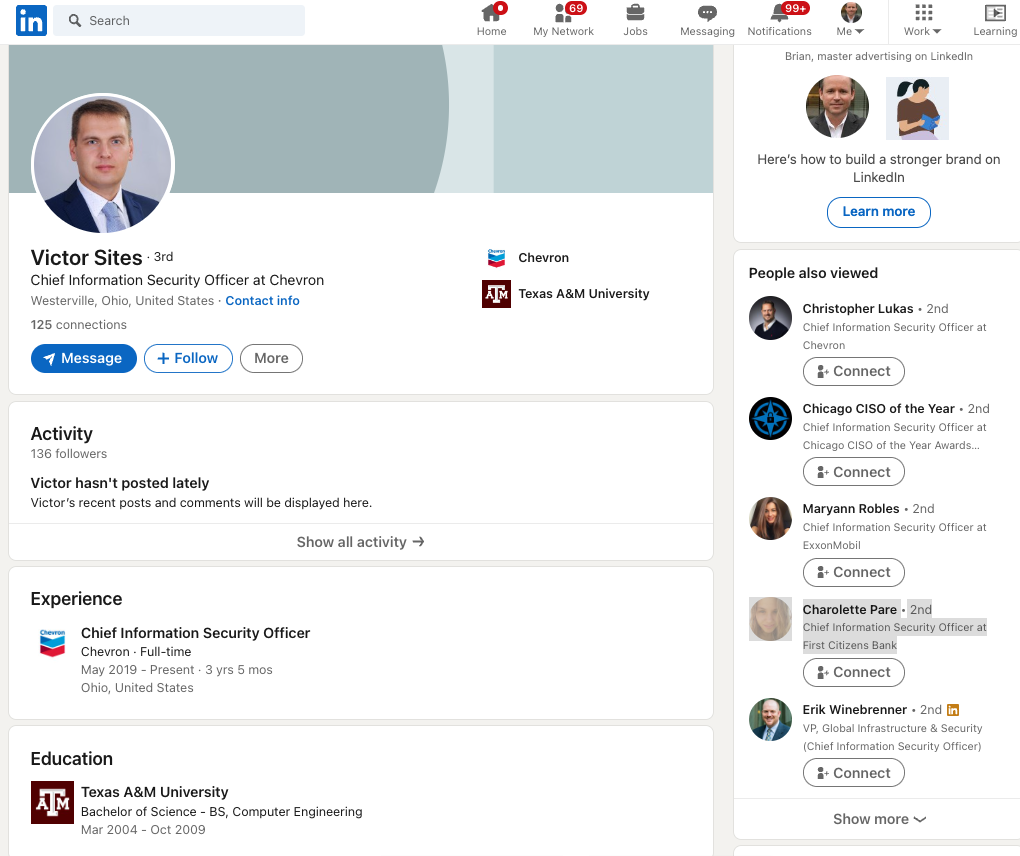
The LinkedIn profile for Victor Sites, who is most certainly NOT the CISO of Chevron.
Of course, Sites is not the real CISO of Chevron. That role is currently occupied by Christopher Lukas of Danville, Calif. If you were confused at this point, you might ask Google who it thinks is the current Chief Information Security Officer of Chevron. When KrebsOnSecurity did that earlier this morning, the fake CISO profile was the very first search result returned (followed by the LinkedIn profile for the real Chevron CISO).

Helpfully, LinkedIn seems to be able to detect something in common about all these fake CISO profiles, because it suggested I view a number of them in the “People Also Viewed” column seen in the image above. There are two fake CISO profiles suggested there, including one for a Maryann Robles, who claims to be the CISO of another energy giant — ExxonMobil.
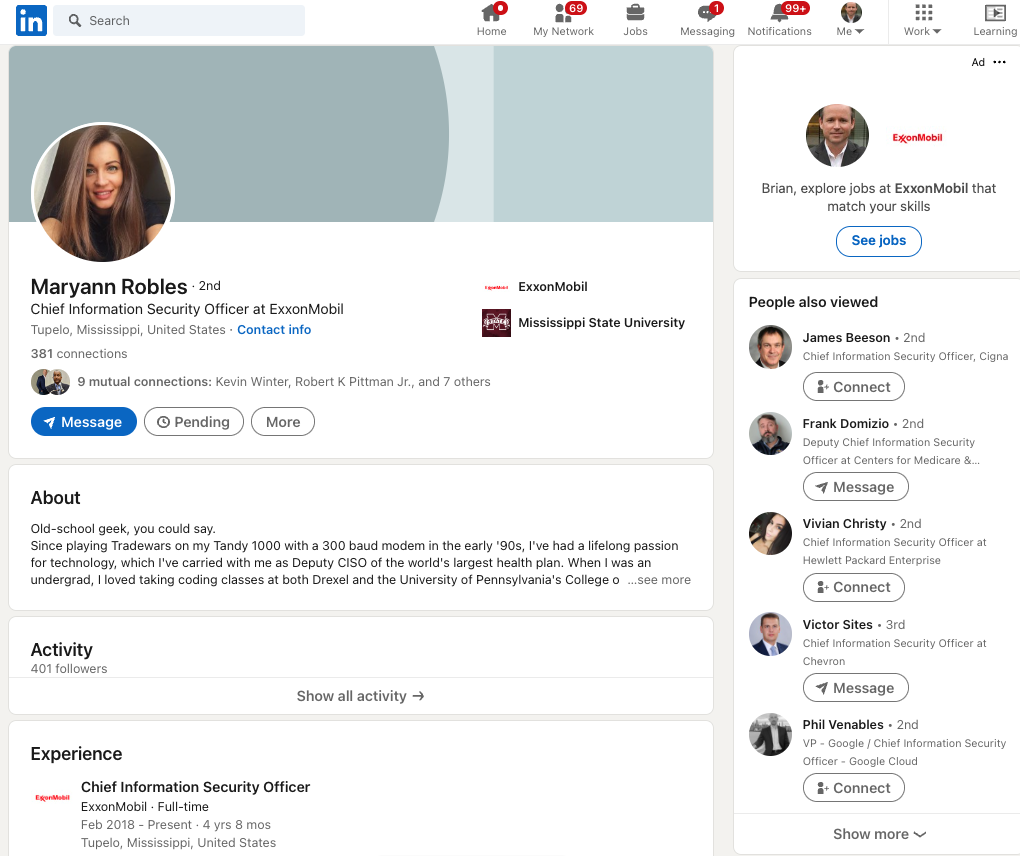
Maryann’s profile says she’s from Tupelo, Miss., and includes this detail about how she became a self-described “old-school geek.”
“Since playing Tradewars on my Tandy 1000 with a 300 baud modem in the early ’90s, I’ve had a lifelong passion for technology, which I’ve carried with me as Deputy CISO of the world’s largest health plan,” her profile reads.
However, this description appears to have been lifted from the profile for the real CISO at the Centers for Medicare & Medicaid Services in Baltimore, Md.
Interestingly, Maryann’s LinkedIn profile was accepted as truth by Cybercrime Magazine’s CISO 500 listing, which claims to maintain a list of the current CISOs at America’s largest companies:

The fake CISO for ExxOnMobil was indexed in Cybercrime Magazine’s CISO 500.
Rich Mason, the former CISO at Fortune 500 firm Honeywell, began warning his colleagues on LinkedIn about the phony profiles earlier this week.
“It’s interesting the downstream sources that repeat LinkedIn bogus content as truth,” Mason said. “This is dangerous, Apollo.io, Signalhire, and Cybersecurity Ventures.”
Google wasn’t fooled by the phony LinkedIn profile for Jennie Biller, who claims to be CISO at biotechnology giant Biogen (the real Biogen CISO is Russell Koste). But Biller’s profile is worth mentioning because it shows how some of these phony profiles appear to be quite hastily assembled. Case in point: Biller’s name and profile photo suggest she is female, however the “About” description of her accomplishments uses male pronouns. Also, it might help that Jennie only has 18 connections on LinkedIn.
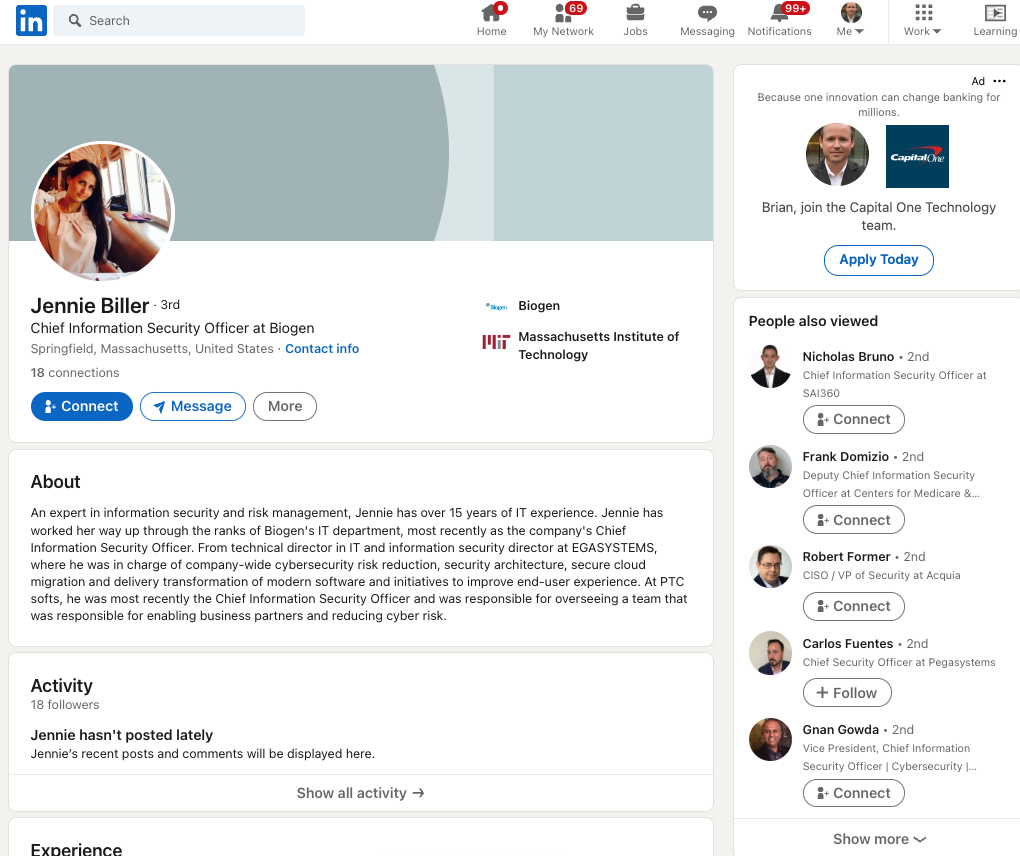
Again, we don’t know much about who or what is behind these profiles, but in August the security firm Mandiant (recently acquired by Google) told Bloomberg that hackers working for the North Korean government have been copying resumes and profiles from leading job listing platforms LinkedIn and Indeed, as part of an elaborate scheme to land jobs at cryptocurrency firms.
None of the profiles listed here responded to requests for comment (or to become a connection).
In a statement provided to KrebsOnSecurity, LinkedIn said its teams were actively working to take these fake accounts down.
“We do have strong human and automated systems in place, and we’re continually improving, as fake account activity becomes more sophisticated,” the statement reads. “In our transparency report we share how our teams plus automated systems are stopping the vast majority of fraudulent activity we detect in our community – around 96% of fake accounts and around 99.1% of spam and scam.”
LinkedIn could take one simple step that would make it far easier for people to make informed decisions about whether to trust a given profile: Add a “created on” date for every profile. Twitter does this, and it’s enormously helpful for filtering out a great deal of noise and unwanted communications.
The former CISO Mason said LinkedIn also could experiment with offering something akin to Twitter’s verified mark to users who chose to validate that they can respond to email at the domain associated with their stated current employer.
“If I saw that a LinkedIn profile had been domain-validated, then my confidence in that profile would go way up,” Mason said, noting that many of the fake profiles had hundreds of followers, including dozens of real CISOs. Maryann’s profile grew by a hundred connections in just the past few days, he said.
“If we have CISOs that are falling for this, what hopes do the masses have?” Mason said.
Mason said LinkedIn also needs a more streamlined process for allowing employers to remove phony employee accounts. He recently tried to get a phony profile removed from LinkedIn for someone who falsely claimed to have worked for his company.
“I shot a note to LinkedIn and said please remove this, and they said, well, we have to contact that person and arbitrate this,” he said. “They gave the guy two weeks and he didn’t respond, so they took it down. But that doesn’t scale, and there needs to be a mechanism where an employer can contact LinkedIn and have these fake profiles taken down in less than two weeks.”
A 36-year-old Russian man recently identified by KrebsOnSecurity as the likely proprietor of the massive RSOCKS botnet has been arrested in Bulgaria at the request of U.S. authorities. At a court hearing in Bulgaria this month, the accused hacker requested and was granted extradition to the United States, reportedly telling the judge, “America is looking for me because I have enormous information and they need it.”

A copy of the passport for Denis Kloster, as posted to his Vkontakte page in 2019.
On June 22, KrebsOnSecurity published Meet the Administrators of the RSOCKS Proxy Botnet, which identified Denis Kloster, a.k.a. Denis Emelyantsev, as the apparent owner of RSOCKS, a collection of millions of hacked devices that were sold as “proxies” to cybercriminals looking for ways to route their malicious traffic through someone else’s computer.
A native of Omsk, Russia, Kloster came into focus after KrebsOnSecurity followed clues from the RSOCKS botnet master’s identity on the cybercrime forums to Kloster’s personal blog, which featured musings on the challenges of running a company that sells “security and anonymity services to customers around the world.” Kloster’s blog even included a group photo of RSOCKS employees.
“Thanks to you, we are now developing in the field of information security and anonymity!,” Kloster’s blog enthused. “We make products that are used by thousands of people around the world, and this is very cool! And this is just the beginning!!! We don’t just work together and we’re not just friends, we’re Family.”
The Bulgarian news outlet 24Chasa.bg reports that Kloster was arrested in June at a co-working space in the southwestern ski resort town of Bansko, and that the accused asked to be handed over to the American authorities.
“I have hired a lawyer there and I want you to send me as quickly as possible to clear these baseless charges,” Kloster reportedly told the Bulgarian court this week. “I am not a criminal and I will prove it in an American court.”
Launched in 2013, RSOCKS was shut down in June 2022 as part of an international investigation into the cybercrime service. According to the Justice Department, the RSOCKS botnet initially targeted Internet of Things (IoT) devices, including industrial control systems, time clocks, routers, audio/video streaming devices, and smart garage door openers; later in its existence, the RSOCKS botnet expanded into compromising additional types of devices, including Android devices and conventional computers, the DOJ said.
The Justice Department’s June 2022 statement about that takedown cited a search warrant from the U.S. Attorney’s Office for the Southern District of California, which also was named by Bulgarian news outlets this month as the source of Kloster’s arrest warrant.
When asked about the existence of an arrest warrant or criminal charges against Kloster, a spokesperson for the Southern District said, “no comment.”
Update, Sept. 24, 9:00 a.m. ET: Kloster was named in a 2019 indictment (PDF) unsealed Sept. 23 by the Southern District court.

The employees who kept things running for RSOCKS, circa 2016. Notice that nobody seems to be wearing shoes.
24Chasa said the defendant’s surname is Emelyantsev and that he only recently adopted the last name Kloster, which is his mother’s maiden name.
As KrebsOnSecurity reported in June, Kloster also appears to be a major player in the Russian email spam industry. In several private exchanges on cybercrime forums, the RSOCKS administrator claimed ownership of the RUSdot spam forum. RUSdot is the successor forum to Spamdot, a far more secretive and restricted forum where most of the world’s top spammers, virus writers and cybercriminals collaborated for years before the community’s implosion in 2010.
Email spam — and in particular malicious email sent via compromised computers — is still one of the biggest sources of malware infections that lead to data breaches and ransomware attacks. So it stands to reason that as administrator of Russia’s most well-known forum for spammers, the defendant in this case probably knows quite a bit about other top players in the botnet spam and malware community.
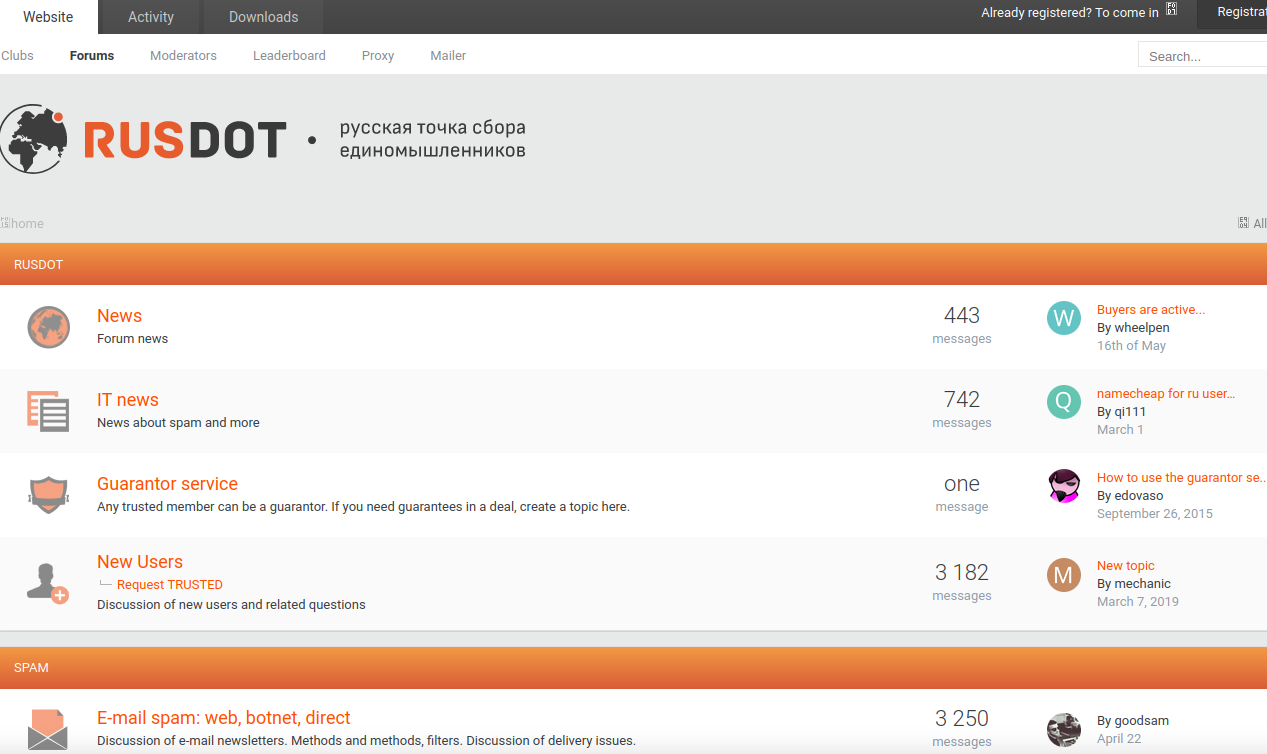
A Google-translated version of the Rusdot spam forum.
Despite maintaining his innocence, Kloster reportedly told the Bulgarian judge that he could be useful to American investigators.
“America is looking for me because I have enormous information and they need it,” Kloster told the court, according to 24Chasa. “That’s why they want me.”
The Bulgarian court agreed, and granted his extradition. Kloster’s fiancee also attended the extradition hearing, and reportedly wept in the hall outside the entire time.
Kloster turned 36 while awaiting his extradition hearing, and may soon be facing charges that carry punishments of up to 20 years in prison.
A Florida teenager who served as a lackey for a cybercriminal group that specializes in cryptocurrency thefts was beaten and kidnapped last week by a rival cybercrime gang. The teen’s captives held guns to his head while forcing him to record a video message pleading with his crew to fork over a $200,000 ransom in exchange for his life. The youth is now reportedly cooperating with U.S. federal investigators, who are responding to an alarming number of reports of physical violence tied to certain online crime communities.
The grisly kidnapping video has been circulating on a number of Telegram chat channels dedicated to SIM-swapping — the practice of tricking or bribing mobile phone store employees into diverting a target’s phone number, text messages and calls to a device the attackers control.
The teen, known to the SIM-swapping community by the handle “Foreshadow,” appears to have served as a “holder” — a term used to describe a low-level member of any SIM-swapping group who agrees to carry out the riskiest and least rewarding role of the crime: Physically keeping and managing the various mobile devices and SIM cards that are used in SIM-swapping scams.
“Yo, Dan, please bro send the 200k,” Foreshadow said in the video, which was shot on Sept. 15 in the backseat of a moving car. Bleeding from a swollen mouth with two handguns pointed at his head, Foreshadow pleaded for his life. A still shot from that video is available here [Warning: the image is quite graphic].
“They’re going to kill me if you don’t,” Foreshadow continued, offering to get a job as a complicit mobile store employee or “plug” to help with future SIM-swaps. “I’ll pay you back. Just let me know what you need. I got you, for real. Any work for free. Whatever. However long you need me, too. I’ll apply to any store you need me to apply to. I can be a plug. I don’t care if I get caught by the cops or anything. I’ll get that money back for you. I used to do that work.”
It’s not clear where in the world the hostage video was recorded. But at one point in the video, the vehicle’s radio can be heard in the background mentioning WMIB, which is a hip-hop station in South Florida that serves both Ft. Lauderdale and Miami.
As Foreshadow’s hostage video began making the rounds on SIM-swapping Telegram channels, a rumor surfaced that Foreshadow had died after being shot in the leg. It soon emerged that Foreshadow had not died, and that he was cooperating with the Federal Bureau of Investigation (FBI). Members of the SIM-swapping community were then warned to delete any messages to or from Foreshadow. One of those messages read:
JUST IN: FORESHADOW IS NOT DEAD!!!!
HES CURRENTLY CO-OPERATING WITH THE FBI DUE TO HIM BEING KIDNAPPED AND AN ATTEMPT TO EXTORT HIM FOR 200K
IF YOU HAVE CHATS WITH HIM CLEAR THEM
Foreshadow appears to be a teenager from Florida whose first name is Justin. Foreshadow’s main Telegram account was converted from a user profile into a channel on Sept. 15 — the same day he was assaulted and kidnapped — and it is not currently responding to messages.
Foreshadow’s erstwhile boss Jarik told KrebsOnSecurity that the youth was indeed shot by his captors, and blamed the kidnapping on a rival SIM-swapper from Australia who was angry over getting shortchanged of the profits from a previous SIM-swapping escapade.
The FBI did not immediately respond to requests for comment.
Reached via Telegram, the alleged mastermind of the kidnapping — a SIM-swapper who uses the handle “Gus” — confirmed that he ordered the attack on Foreshadow because the holder had held back some of his stolen funds. In the same breath, Gus said Jarik was “gonna get done in next” for sharing Gus’ real name and address with KrebsOnSecurity.
“No1 cared about that nigga anyway, he snaked targs [targets] and flaunted it everywhere,” Gus said of Foreshadow. “I’ve been fucked over so many times I’ve lost millions. I am just a guy trying to make more money.”
Foreshadow’s experience is the latest example of a rapidly escalating cycle of physical violence that is taking hold of criminal SIM-swapping communities online. Earlier this month, KrebsOnSecurity detailed how multiple SIM-swapping Telegram channels are now replete with “violence-as-a-service” offerings, wherein denizens of the underground hire themselves out to perform various forms of physical violence — from slashing tires and throwing a brick through someone’s window, to conducting drive-by shootings, firebombings and home invasions.
On Aug. 12, 2022, 21-year-old Patrick McGovern-Allen of Egg Harbor Township, N.J. was arrested by the FBI and charged with stalking in connection with several of these violence-as-a-service jobs. Prosecutors say the defendant fired a handgun into a Pennsylvania home, and helped to torch another residence in the state with a Molotov Cocktail — all allegedly in service of a beef over stolen cryptocurrency.
Earlier this month, three men in the United Kingdom were arrested for attempting to assault a local man and steal his virtual currencies. The local man’s neighbor called the cops and said the three men were acting suspiciously and that one of them was wearing a police uniform. U.K. police stopped the three men allegedly fleeing the scene, and found a police uniform and weapons in the trunk of the car. All three defendants in that case were charged with “intent to cause loss to another to make an unwarranted demand of Crypto Currency from a person.”
Dina Temple-Raston and Sean Powers over at The Record recently interviewed several members of the SIM-swapping community about this escalation in violence. That story is also available on the Click Here podcast — Throwing Bricks for $$$: Violence-as-a-Service Comes of Age.
Three men in the United Kingdom were arrested this month for attempting to assault a local man and steal his virtual currencies. The incident is the latest example of how certain cybercriminal communities are increasingly turning to physical violence to settle scores and disputes.

Shortly after 11 p.m. on September 6, a resident in the Spalding Common area in the district of Lincolnshire, U.K. phoned police to say three men were acting suspiciously, and had jumped a nearby fence.
“The three men made off in a VW Golf and were shortly stopped nearby,” reads a statement by the Lincolnshire Police. “The car was searched by officers who found an imitation firearm, taser, a baseball bat and police uniform in the boot.”
Thomas Green, 23, Rayhan Miah, 23, and Leonardo Sapiano, 24 were all charged with possession of the weapons, and “with intent to cause loss to another to make an unwarranted demand of Crypto Currency from a person.”
KrebsOnSecurity has learned that the defendants were in Spalding Common to pay a surprise visit to a 19-year-old hacker known by the handles “Discoli,” “Disco Dog,” and “Chinese.” In December 2020, Discoli took credit for hacking and leaking the user database for OGUsers, a forum overrun with people looking to buy, sell and trade access to compromised social media accounts.
Reached via Telegram, Discoli confirmed that police believe the trio was trying to force their way into his home in Spalding Common, and that one of them was wearing a police uniform when they approached his residence.
“They were obvious about being fake police, so much so that one of our neighbours called,” Discoli said in an instant message chat. “That call led to the arrests. Their intent was for robbery/blackmail of crypto, I just happened to not be home at the time.”
The Lincolnshire Police declined to comment for this story, citing an ongoing investigation.
Discoli said he didn’t know any of the men charged, but believes they were hired by one of his enemies. And he said his would-be assailants didn’t just target him specifically.
“They had a list of people they wanted to hit consecutively as far as I know,” he said.
The foiled robbery is the latest drama tied to members of certain criminal hacking communities who are targeting one another with physical violence, by making a standing offer to pay thousands of dollars to anyone in the target’s region who agrees to carry out the assaults.
Last month, a 21-year-old New Jersey man was arrested and charged with stalking in connection with a federal investigation into groups of cybercriminals who are settling scores by hiring people to carry out physical attacks on their rivals.
Prosecutors say Patrick McGovern-Allen recently participated in several of these schemes — including firing a handgun into a Pennsylvania home and torching a residence in another part of the state with a Molotov Cocktail.
McGovern-Allen and the three U.K. defendants are part of an online community that is at the forefront of a dangerous escalation in coercion and intimidation tactics increasingly used by competing cybercriminal groups to steal cryptocurrency from one another and to keep their rivals in check.
The Telegram chat channels where these young men transact have hundreds to thousands of members each, and some of the more interesting solicitations on these communities are job offers for in-person assignments and tasks that can be found if one searches for posts titled, “If you live near,” or “IRL job” — short for “in real life” job.
A number of these classified ads are in service of performing “brickings,” where someone is hired to visit a specific address and toss a brick through the target’s window. Indeed, prior to McGovern-Allen’s arrest, his alleged Telegram persona bragged that he’d carried out several brickings for hire.
Many of the individuals involved in paying others to commit these physical attacks are also frequent participants in Telegram chat channels focused singularly on SIM swapping, a crime in which identity thieves hijack a target’s mobile phone number and use that to wrest control over the victim’s various online accounts and identities.
Unsurprisingly, the vast majority of people currently being targeted for brickings and other real-life physical assaults via Telegram tend to be other cybercriminals involved in SIM swapping crimes (or individuals on the periphery of that scene).
The United Kingdom is home to a number of young men accused of stealing millions of dollars worth of cryptocurrencies via SIM swapping. Joseph James O’Connor, a.k.a. “Plugwalk Joe”, was arrested in Spain in July 2021 under an FBI warrant on 10 counts of offenses related to unauthorized computer access and cyber bullying. U.S. investigators say O’Connor also played a central role in the 2020 intrusion at Twitter, wherein Twitter accounts for top celebrities and public figures were forced to tweet out links to cryptocurrency scams. O’Connor is currently fighting extradition to the United States.
Robert Lewis Barr, a 25-year-old Scottish man who allegedly stole more than $8 million worth of crypto, was arrested on an FBI warrant last year and is also fighting his extradition. U.S. investigators say Barr SIM swapped a U.S. bitcoin broker in 2017, and that he spent much of the stolen funds throwing lavish parties at rented luxury apartments in central Glasgow.
In many ways, these violence-as-a-service incidents are a natural extension of “swatting,” wherein fake bomb threats, hostage situations and other violent scenarios are phoned in to police as part of a scheme to trick them into visiting potentially deadly force on a target’s address. According to prosecutors, both Barr and O’Connor have a history of swatting their enemies and their SIM swapping victims.
A number of financial institutions in and around New York City are dealing with a rash of super-thin “deep insert” skimming devices designed to fit inside the mouth of an ATM’s card acceptance slot. The card skimmers are paired with tiny pinhole cameras that are cleverly disguised as part of the cash machine. Here’s a look at some of the more sophisticated deep insert skimmer technology that fraud investigators have recently found in the wild.

This ultra thin and flexible “deep insert” skimmer recently recovered from an NCR cash machine in New York is about half the height of a U.S. dime. The large yellow rectangle is a battery. Image: KrebsOnSecurity.com.
The insert skimmer pictured above is approximately .68 millimeters tall. This leaves more than enough space to accommodate most payment cards (~.54 mm) without interrupting the machine’s ability to grab and return the customer’s card. For comparison, this flexible skimmer is about half the height of a U.S. dime (1.35 mm).
These skimmers do not attempt to siphon chip-card data or transactions, but rather are after the cardholder data still stored in plain text on the magnetic stripe on the back of most payment cards issued to Americans.
Here’s what the other side of that insert skimmer looks like:

The other side of the deep insert skimmer. Image: KrebsOnSecurity.com.
The thieves who designed this skimmer were after the magnetic stripe data and the customer’s 4-digit personal identification number (PIN). With those two pieces of data, the crooks can then clone payment cards and use them to siphon money from victim accounts at other ATMs.
To steal PINs, the fraudsters in this case embedded pinhole cameras in a false panel made to fit snugly over the cash machine enclosure on one side of the PIN pad.

Pinhole cameras were hidden in these false side panels glued to one side of the ATM, and angled toward the PIN pad. Image: KrebsOnSecurity.com.
The skimming devices pictured above were pulled from a brand of ATMs made by NCR called the NCR SelfServ 84 Walk-Up. In January 2022, NCR produced a report on motorized deep insert skimmers, which offers a closer look at other insert skimmers found targeting this same line of ATMs.
Here are some variations on deep insert skimmers NCR found in recent investigations:

Image: NCR.

Image: NCR
The NCR report included additional photos that show how fake ATM side panels with the hidden cameras are carefully crafted to slip over top of the real ATM side panels.

Image: NCR.
Sometimes the skimmer thieves embed their pinhole spy cameras in fake panels directly above the PIN pad, as in these recent attacks targeting a similar NCR model:

Image: NCR
In the image below, the thieves hid their pinhole camera in a “consumer awareness mirror” placed directly above an ATM retrofitted with an insert skimmer:

Image: NCR
The financial institution that shared the images above said it has seen success in stopping most of these insert skimmer attacks by incorporating a solution that NCR sells called an “insert kit,” which it said stops current insert skimmer designs. NCR also is conducting field trials on a “smart detect kit” that adds a standard USB camera to view the internal card reader area, and uses image recognition software to identify any fraudulent device inside the reader.
Skimming devices will continue to mature in miniaturization and stealth as long as payment cards continue to hold cardholder data in plain text on a magnetic stripe. It may seem silly that we’ve spent years rolling out more tamper- and clone-proof chip-based payment cards, only to undermine this advance in the name of backwards compatibility. However, there are a great many smaller businesses in the United States that still rely on being able to swipe the customer’s card.
Many newer ATM models, including the NCR SelfServ referenced throughout this post, now include contactless capability, meaning customers no longer need to insert their ATM card anywhere: They can instead just tap their smart card against the wireless indicator to the left of the card acceptance slot (and right below the “Use Mobile Device Here” sign on the ATM).
For simple ease-of-use reasons, this contactless feature is now increasingly prevalent at drive-thru ATMs. If your payment card supports contactless technology, you will notice a wireless signal icon printed somewhere on the card — most likely on the back. ATMs with contactless capabilities also feature this same wireless icon.
Once you become aware of ATM skimmers, it’s difficult to use a cash machine without also tugging on parts of it to make sure nothing comes off. But the truth is you probably have a better chance of getting physically mugged after withdrawing cash than you do encountering a skimmer in real life.
So keep your wits about you when you’re at the ATM, and avoid dodgy-looking and standalone cash machines in low-lit areas, if possible. When possible, stick to ATMs that are physically installed at a bank. And be especially vigilant when withdrawing cash on the weekends; thieves tend to install skimming devices on Saturdays after business hours — when they know the bank won’t be open again for more than 24 hours.
Lastly but most importantly, covering the PIN pad with your hand defeats one key component of most skimmer scams: The spy camera that thieves typically hide somewhere on or near the compromised ATM to capture customers entering their PINs.
Shockingly, few people bother to take this simple, effective step. Or at least, that’s what KrebsOnSecurity found in this skimmer tale from 2012, wherein we obtained hours worth of video seized from two ATM skimming operations and saw customer after customer walk up, insert their cards and punch in their digits — all in the clear.
If you enjoyed this story, check out these related posts:
Crooks Go Deep With Deep Insert Skimmers
This month’s Patch Tuesday offers a little something for everyone, including security updates for a zero-day flaw in Microsoft Windows that is under active attack, and another Windows weakness experts say could be used to power a fast-spreading computer worm. Also, Apple has also quashed a pair of zero-day bugs affecting certain macOS and iOS users, and released iOS 16, which offers a new privacy and security feature called “Lockdown Mode.” And Adobe axed 63 vulnerabilities in a range of products.

Microsoft today released software patches to plug at least 64 security holes in Windows and related products. Worst in terms of outright scariness is CVE-2022-37969, which is a “privilege escalation” weakness in the Windows Common Log File System Driver that allows attackers to gain SYSTEM-level privileges on a vulnerable host. Microsoft says this flaw is already being exploited in the wild.
Kevin Breen, director of cyber threat research at Immersive Labs, said any vulnerability that is actively targeted by attackers in the wild must be put to the top of any patching list.
“Not to be fooled by its relatively low CVSS score of 7.8, privilege escalation vulnerabilities are often highly sought after by cyber attackers,” Breen said. “Once an attacker has managed to gain a foothold on a victim’s system, one of their first actions will be to gain a higher level of permissions, allowing the attacker to disable security applications and any device monitoring. There is no known workaround to date, so patching is the only effective mitigation.”
Satnam Narang at Tenable said CVE-2022-24521 — a similar vulnerability in the same Windows log file component — was patched earlier this year as part of Microsoft’s April Patch Tuesday release and was also exploited in the wild.
“CVE-2022-37969 was disclosed by several groups, though it’s unclear if CVE-2022-37969 is a patch-bypass for CVE-2022-24521 at this point,” Narang said.
Another vulnerability Microsoft patched this month — CVE-2022-35803 — also seems to be related to the same Windows log file component. While there are no indications CVE-2022-35803 is being actively exploited, Microsoft suggests that exploitation of this flaw is more likely than not.
Trend Micro’s Dustin Childs called attention to CVE-2022-34718, a remote code execution flaw in the Windows TCP/IP service that could allow an unauthenticated attacker to execute code with elevated privileges on affected systems without user interaction.
“That officially puts it into the ‘wormable’ category and earns it a CVSS rating of 9.8,” Childs said. “However, only systems with IPv6 enabled and IPSec configured are vulnerable. While good news for some, if you’re using IPv6 (as many are), you’re probably running IPSec as well. Definitely test and deploy this update quickly.”
Cisco Talos warns about four critical vulnerabilities fixed this month — CVE-2022-34721 and CVE-2022-34722 — which have severity scores of 9.8, though they are “less likely” to be exploited, according to Microsoft.
“These are remote code execution vulnerabilities in the Windows Internet Key Exchange protocol that could be triggered if an attacker sends a specially crafted IP packet,” wrote Jon Munshaw and Asheer Malhotra. “Two other critical vulnerabilities, CVE-2022-35805 and CVE-2022-34700 exist in on-premises instances of Microsoft Dynamics 365. An authenticated attacker could exploit these vulnerabilities to run a specially crafted trusted solution package and execute arbitrary SQL commands. The attacker could escalate their privileges further and execute commands as the database owner.”
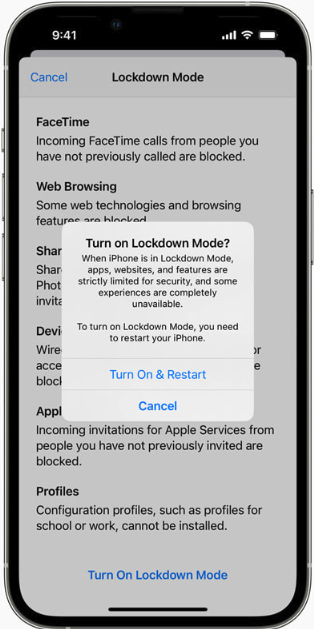 Not to be outdone, Apple fixed at least two zero-day vulnerabilities when it released updates for iOS, iPadOS, macOS and Safari. CVE-2022-32984 is a problem in the deepest recesses of the operating system (the kernel). Apple pushed an emergency update for a related zero-day last month in CVE-2022-32983, which could be used to foist malware on iPhones, iPads and Macs that visited a booby-trapped website.
Not to be outdone, Apple fixed at least two zero-day vulnerabilities when it released updates for iOS, iPadOS, macOS and Safari. CVE-2022-32984 is a problem in the deepest recesses of the operating system (the kernel). Apple pushed an emergency update for a related zero-day last month in CVE-2022-32983, which could be used to foist malware on iPhones, iPads and Macs that visited a booby-trapped website.
Also listed under active attack is CVE-2022-32817, which has been fixed on macOS 12.6 (Monterey), macOS 11.7 (Big Sur), iOS 15.7 and iPadOS 15.7, and iOS 16. The same vulnerability was fixed in Apple Watch in July 2022, and credits Xinru Chi of Japanese cybersecurity firm Pangu Lab.
“Interestingly, this CVE is also listed in the advisory for iOS 16, but it is not called out as being under active exploit for that flavor of the OS,” Trend Micro’s Childs noted. “Apple does state in its iOS 16 advisory that ‘Additional CVE entries to be added soon.’ It’s possible other bugs could also impact this version of the OS. Either way, it’s time to update your Apple devices.”
Apple’s iOS 16 includes two new security and privacy features — Lockdown Mode and Safety Check. Wired.com describes Safety Check as a feature for users who are at risk for, or currently experiencing, domestic abuse.
“The tool centralizes a number of controls in one place to make it easier for users to manage and revoke access to their location data and reset privacy-related permissions,” wrote Lily Hay Newman.
“Lockdown Mode, on the other hand, is meant for users who potentially face targeted spyware attacks and aggressive state-backed hacking. The feature comprehensively restricts any nonessential iOS features so there are as few potential points of entry to a device as possible. As more governments and repressive entities around the world have begun purchasing powerful commodity spyware to target individuals of particular importance or interest, iOS’s general security defenses haven’t been able to keep pace with these specialized threats.”
To turn on Lockdown Mode in iOS 16, go to Settings, then Privacy and Security, then Lockdown Mode. Safety Check is located in the same area.
Finally, Adobe released seven patches addressing 63 security holes in Adobe Experience Manager, Bridge, InDesign, Photoshop, InCopy, Animate, and Illustrator. More on those updates is here.
Don’t forget to back up your data and/or system before applying any security updates. If you experience glitches or problems installing any of these patches this month, please consider leaving a comment about it below; there’s a decent chance other readers have experienced the same and may chime in here with useful tips.
Communities like Craigslist, OfferUp, Facebook Marketplace and others are great for finding low- or no-cost stuff that one can pick up directly from a nearby seller, and for getting rid of useful things that don’t deserve to end up in a landfill. But when dealing with strangers from the Internet, there is always a risk that the person you’ve agreed to meet has other intentions.
Nearly all U.S. states now have designated safe trading stations — mostly at local police departments — which ensure that all transactions are handled in plain view of both the authorities and security cameras.

These safe trading places exist because sometimes in-person transactions from the Internet don’t end well for one or more parties involved. The website Craigslistkillers has catalogued news links for at least 132 murders linked to Craigslist transactions since 2015. Many of these killings involved high-priced items like automobiles and consumer electronics, where the prospective buyer apparently intended all along to kill the owner and steal the item offered for sale. Others were motivated simply by a desire to hurt people.
This is not to say that using Craigslist is uniquely risky or dangerous; I’m sure the vast majority of transactions generated by the site end amicably and without physical violence. And that probably holds true for all of Craigslist’s competitors.
Still, the risk of a deal going badly when one meets total strangers from the Internet is not zero, and so it’s only sensible to take a few simple precautions. For example, choosing to transact at a designated safe place such as a police station dramatically reduces the likelihood that anyone wishing you harm would even show up.
I recently stumbled upon one of these designated exchange places by accident, hence my interest in learning more about them. The one I encountered was at a Virginia county sheriff’s office, and it has two parking spots reserved with a sign that reads, “Internet Purchase & Exchange Location: This Area is Under 24 Hour Video Surveillance” [image above].
According to the list maintained at Safetradestations.com, there are four other such designated locations in Northern Virginia. And it appears most states now have them in at least some major cities. Safeexchangepoint.com also has a searchable index of safe trading locations in the United States and Canada.
Granted, not everyone is going to live close to one of these designated trading stations. Or maybe what you want to buy, sell or trade you’d rather not have recorded in front of police cameras. Either way, here are a few tips on staying safe while transacting in real life with strangers from the Internet (compliments of the aforementioned safe trading websites).
The safest exchange points are easily accessible and in a well-lit, public place where transactions are visible to others nearby. Try to arrange a meeting time that is during daylight hours, and consider bringing a friend along — especially when dealing with high-value items like laptops and smart phones.
Safeexchangepoint.com also advises that police or merchants that host their own exchange locations generally won’t get involved in the details of your transaction unless specified otherwise, and that many police departments (but not all) are willing to check the serial number of an item for sale to make sure it’s not known to be stolen property.
Of course, it’s not always practical or possible to haul that old sofa to the local police department, or a used car that isn’t working. In those situations, safetradestations.com has some decent suggestions:
A 21-year-old New Jersey man has been arrested and charged with stalking in connection with a federal investigation into groups of cybercriminals who are settling scores by hiring people to carry out physical attacks on their rivals. Prosecutors say the defendant recently participated in several of these schemes — including firing a handgun into a Pennsylvania home and torching a residence in another part of the state with a Molotov Cocktail.
Patrick McGovern-Allen of Egg Harbor Township, N.J. was arrested on Aug. 12 on a warrant from the U.S. Federal Bureau of Investigation. An FBI complaint alleges McGovern-Allen was part of a group of co-conspirators who are at the forefront of a dangerous escalation in coercion and intimidation tactics increasingly used by competing cybercriminal groups.
Prosecutors say that around 2 a.m. on Jan 2, 2022, McGovern-Allen and an unidentified co-conspirator fired multiple handgun rounds into a residence in West Chester, Pa. Fortunately, none of the residents inside the home at the time were injured. But prosecutors say the assailants actually recorded video of the attack as “proof” that the shooting had been carried out.
A copy of that video was obtained by KrebsOnSecurity. According to investigators, McGovern-Allen was one of the shooters, who yelled “Justin Active was here” as they haphazardly fired at least eight rounds into the lower story of the West Chester residence.
On Dec. 18, 2021, police in Abington Township, Pa., responded to reports of a house fire from homeowners who said it sounded like something was thrown at their residence just prior to the fire.
Weeks later, on the day of the shooting in West Chester, a detective with the Westtown East Goshen Police Department contacted the Abington police and shared another video that was circulating on several online message boards that appeared to show two individuals setting fire to the Abington Township residence. The criminal complaint said the two police officers agreed the same suspect was present in both videos.
A copy of that video also was obtained by KrebsOnSecurity, and it shows at least two individuals smashing a window, then lighting a rag-soaked Mad Dog 20/20 grape wine bottle and hurling it at the side of the home [Update: My apologies for the file download link, but YouTube just deleted both of the videos included in this story — for allegedly violating their community standards].
“The Molotov cocktail caused the immediate surrounding area to ignite, including the siding of the house, grass, and the wooden chair,” the government’s complaint against McGovern-Allen states. “The two suspects then fled on foot toward the street and begin yelling something when the video stops.”
The government mentions the victims only by their initials — “K.M.” in the shooting and “A.R.” in the firebombing — but said both had been the target of previous harassment by rival cybercriminal groups that included swatting attacks, wherein the perpetrators spoof a distress call to the police about a hostage situation, suicide or bomb threat with the goal of sending a heavily-armed police response to a targeted address.
A number of previous swatting incidents have turned deadly. But these more “hands-on” and first person attacks are becoming increasingly common within certain cybercriminal communities, particularly those engaged in SIM swapping, a crime in which identity thieves hijack a target’s mobile phone number and use that to wrest control over the victim’s various online accounts and identities.
The complaint mentions a handle and user ID allegedly used by McGovern-Allen’s online persona “Tongue” on the Discord chat service, (user: “Tongue#0001”).
“In the chats, [Tongue] tells other Discord users that he was the person who shot K.M.’s house and that he was willing to commit firebombings using Molotov Cocktails,” the complaint alleges. “For example, in one Discord chat from March 2022, [the defendant] states ‘if you need anything done for $ lmk [“let me know”]/I did a shooting/Molotov/but I can also do things for ur entertainment.”
KrebsOnsecurity reviewed hundreds of chat records tied to this Tongue alias, and it appears both attacks were motivated by a desire to get back at a rival cybercriminal by attacking the female friends of that rival.
Recall that the shooters in the West Chester, Pa. incident shouted “Justin Active was here.” Justin Active is the nickname of an individual who is just as active in the same cybercriminal channels, but who has vehemently denied knowledge of or participation in the shooting. Justin Active said on Telegram that the person targeted in the shooting was his ex-girlfriend, and that the firebombing targeted another friend of his.
Justin Active has claimed for months that McGovern-Allen was responsible for both attacks, saying they were intended as an intimidation tactic against him. “DO THE PATRICK MCGOVERN ALLEN RAID DANCE!,” Justin Active’s alias “Nutcase68” shouted on Telegram on Aug. 12, the same day McGovern-Allen was arrested by authorities.
Justin Active’s version of events seems to be supported by a reference in the criminal complaint to an April 2, 2022 chat in which Tongue explained the reason for the shooting.
“The video/is [K]’s house/getting shit/shot/justin active/ was her current bf/ the reason it happened,” Tongue explained. “So that’s why Justin active was there.”
The Telegram chat channels that Justin Active and Tongue both frequented have hundreds to thousands of members each, and some of the more interesting solicitations on these communities are job offers for in-person assignments and tasks that can be found if one searches for posts titled, “If you live near,” or “IRL job” — short for “in real life” job.

A number of these classified ads are in service of performing “brickings,” where someone is hired to visit a specific address and toss a brick through the target’s window.
“If you live near Edmonton Canada dm me need someone bricked,” reads on Telegram message on May 31, 2022.
“If you live near [address redacted] Lakewood, CA, dm [redacted] Paying 3k to slash the tires,” reads another help wanted ad in the same channel on Feb. 24, 2022. “If you live near here and can brick them, dm [address omitted] Richland, WA,” reads another from that same day.

McGovern-Allen was in the news not long ago. According to a Sept. 2020 story from The Press of Atlantic City, a then 19-year-old Patrick McGovern Allen was injured after driving into a building and forcing residents from their home.
“Police found a 2007 Lexus, driven by Patrick McGovern-Allen, 19, that had lost control and left the road, crashing into the eastern end of the 1600 building,” the story recounted. “The car was driven through the steps that provide access to the second-floor apartments, destroying them, and also caused damage to the outer wall.”

A search on the Inmate Locator of the U.S. Bureau of Prisons website shows that McGovern-Allen remains in federal custody at a detention facility in Philadelphia. He’s currently represented by a public defender who has not responded to requests for comment.
A copy of the criminal complaint against McGovern-Allen is available here (PDF).
Many of the individuals involved in paying others to commit these physical attacks are also frequent participants in several Telegram channels focused singularly on SIM swapping activity. As a result, the vast majority of the people being targeted for brickings and other real-life physical assaults tend to be other cybercriminals involved in SIM swapping crimes (or individuals on the periphery of that scene).
There are dozens of SIM swappers who are now teenage or 20-something millionaires, by virtue of having stolen vast sums of cryptocurrencies from SIM swapping victims. And now many of these same individuals are finding that communities like Telegram can be leveraged to hire physical harassment and intimidation of their rivals and competitors.
The primary barrier to hiring someone to brick a home or slash some tires seems to be the costs involved: A number of solicitations for these services advertised payment of $3,000 or more upon proof of successful completion, which usually involves recording the attack and hiring a getaway driver in the town where the crime is to take place (calling a cab or hailing an Uber from the scene of a bricking isn’t the brightest idea).
My fear is these violence-as-a-service offerings will at some point migrate outside of the SIM swapping communities. This is precisely what happened with swatting, which for years was a crime perpetrated almost exclusively against online gamers and people streaming their games online. These days, swatting attacks are commonly used by SIM swapping groups as a way to harass and extort regular Internet users into giving up prized social media account names that can be resold for thousands of dollars.
Last year, I posted a series of articles about a purported “breach” at Ubiquiti. My sole source for that reporting was the person who has since been indicted by federal prosecutors for his alleged wrongdoing – which includes providing false information to the press.
As a result of the new information that has been provided to me, I no longer have faith in the veracity of my source or the information he provided to me. I always endeavor to ensure that my articles are properly sourced and factual.
This time, I missed the mark and, as a result, I would like to extend my sincerest apologies to Ubiquiti, and I have decided to remove those articles from my website.
Phishers are enjoying remarkable success using text messages to steal remote access credentials and one-time passcodes from employees at some of the world’s largest technology companies and customer support firms. A recent spate of SMS phishing attacks from one cybercriminal group has spawned a flurry of breach disclosures from affected companies, which are all struggling to combat the same lingering security threat: The ability of scammers to interact directly with employees through their mobile devices.

In mid-June 2022, a flood of SMS phishing messages began targeting employees at commercial staffing firms that provide customer support and outsourcing to thousands of companies. The missives asked users to click a link and log in at a phishing page that mimicked their employer’s Okta authentication page. Those who submitted credentials were then prompted to provide the one-time password needed for multi-factor authentication.
The phishers behind this scheme used newly-registered domains that often included the name of the target company, and sent text messages urging employees to click on links to these domains to view information about a pending change in their work schedule.
The phishing sites leveraged a Telegram instant message bot to forward any submitted credentials in real-time, allowing the attackers to use the phished username, password and one-time code to log in as that employee at the real employer website. But because of the way the bot was configured, it was possible for security researchers to capture the information being sent by victims to the public Telegram server.
This data trove was first reported by security researchers at Singapore-based Group-IB, which dubbed the campaign “0ktapus” for the attackers targeting organizations using identity management tools from Okta.com.
“This case is of interest because despite using low-skill methods it was able to compromise a large number of well-known organizations,” Group-IB wrote. “Furthermore, once the attackers compromised an organization they were quickly able to pivot and launch subsequent supply chain attacks, indicating that the attack was planned carefully in advance.”
It’s not clear how many of these phishing text messages were sent out, but the Telegram bot data reviewed by KrebsOnSecurity shows they generated nearly 10,000 replies over approximately two months of sporadic SMS phishing attacks targeting more than a hundred companies.
A great many responses came from those who were apparently wise to the scheme, as evidenced by the hundreds of hostile replies that included profanity or insults aimed at the phishers: The very first reply recorded in the Telegram bot data came from one such employee, who responded with the username “havefuninjail.”
Still, thousands replied with what appear to be legitimate credentials — many of them including one-time codes needed for multi-factor authentication. On July 20, the attackers turned their sights on internet infrastructure giant Cloudflare.com, and the intercepted credentials show at least three employees fell for the scam.
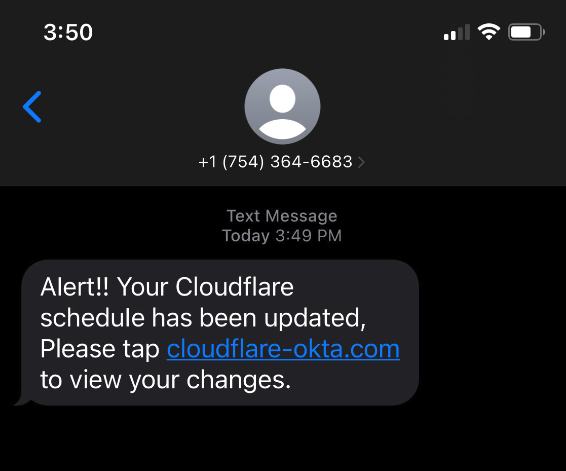
Image: Cloudflare.com
In a blog post earlier this month, Cloudflare said it detected the account takeovers and that no Cloudflare systems were compromised. Cloudflare said it does not rely on one-time passcodes as a second factor, so there was nothing to provide to the attackers. But Cloudflare said it wanted to call attention to the phishing attacks because they would probably work against most other companies.
“This was a sophisticated attack targeting employees and systems in such a way that we believe most organizations would be likely to be breached,” Cloudflare CEO Matthew Prince wrote. “On July 20, 2022, the Cloudflare Security team received reports of employees receiving legitimate-looking text messages pointing to what appeared to be a Cloudflare Okta login page. The messages began at 2022-07-20 22:50 UTC. Over the course of less than 1 minute, at least 76 employees received text messages on their personal and work phones. Some messages were also sent to the employees family members.”
On three separate occasions, the phishers targeted employees at Twilio.com, a San Francisco based company that provides services for making and receiving text messages and phone calls. It’s unclear how many Twilio employees received the SMS phishes, but the data suggest at least four Twilio employees responded to a spate of SMS phishing attempts on July 27, Aug. 2, and Aug. 7.
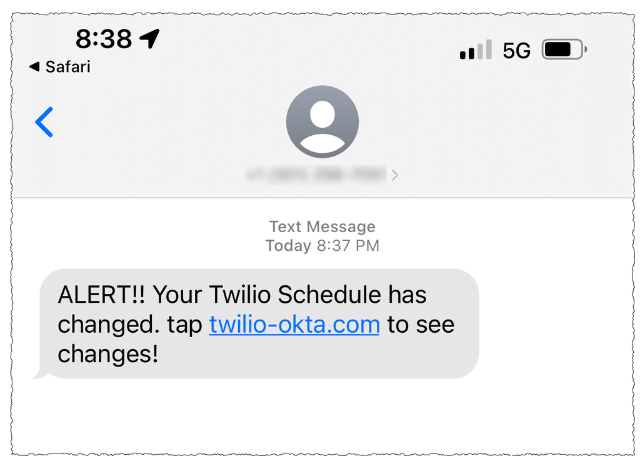
On that last date, Twilio disclosed that on Aug. 4 it became aware of unauthorized access to information related to a limited number of Twilio customer accounts through a sophisticated social engineering attack designed to steal employee credentials.
“This broad based attack against our employee base succeeded in fooling some employees into providing their credentials,” Twilio said. “The attackers then used the stolen credentials to gain access to some of our internal systems, where they were able to access certain customer data.”
That “certain customer data” included information on roughly 1,900 users of the secure messaging app Signal, which relied on Twilio to provide phone number verification services. In its disclosure on the incident, Signal said that with their access to Twilio’s internal tools the attackers were able to re-register those users’ phone numbers to another device.
On Aug. 25, food delivery service DoorDash disclosed that a “sophisticated phishing attack” on a third-party vendor allowed attackers to gain access to some of DoorDash’s internal company tools. DoorDash said intruders stole information on a “small percentage” of users that have since been notified. TechCrunch reported last week that the incident was linked to the same phishing campaign that targeted Twilio.
This phishing gang apparently had great success targeting employees of all the major mobile wireless providers, but most especially T-Mobile. Between July 10 and July 16, dozens of T-Mobile employees fell for the phishing messages and provided their remote access credentials.
“Credential theft continues to be an ongoing issue in our industry as wireless providers are constantly battling bad actors that are focused on finding new ways to pursue illegal activities like this,” T-Mobile said in a statement. “Our tools and teams worked as designed to quickly identify and respond to this large-scale smishing attack earlier this year that targeted many companies. We continue to work to prevent these types of attacks and will continue to evolve and improve our approach.”
This same group saw hundreds of responses from employees at some of the largest customer support and staffing firms, including Teleperformanceusa.com, Sitel.com and Sykes.com. Teleperformance did not respond to requests for comment. KrebsOnSecurity did hear from Christopher Knauer, global chief security officer at Sitel Group, the customer support giant that recently acquired Sykes. Knauer said the attacks leveraged newly-registered domains and asked employees to approve upcoming changes to their work schedules.
Knauer said the attackers set up the phishing domains just minutes in advance of spamming links to those domains in phony SMS alerts to targeted employees. He said such tactics largely sidestep automated alerts generated by companies that monitor brand names for signs of new phishing domains being registered.
“They were using the domains as soon as they became available,” Knauer said. “The alerting services don’t often let you know until 24 hours after a domain has been registered.”
On July 28 and again on Aug. 7, several employees at email delivery firm Mailchimp provided their remote access credentials to this phishing group. According to an Aug. 12 blog post, the attackers used their access to Mailchimp employee accounts to steal data from 214 customers involved in cryptocurrency and finance.
On Aug. 15, the hosting company DigitalOcean published a blog post saying it had severed ties with MailChimp after its Mailchimp account was compromised. DigitalOcean said the MailChimp incident resulted in a “very small number” of DigitalOcean customers experiencing attempted compromises of their accounts through password resets.
According to interviews with multiple companies hit by the group, the attackers are mostly interested in stealing access to cryptocurrency, and to companies that manage communications with people interested in cryptocurrency investing. In an Aug. 3 blog post from email and SMS marketing firm Klaviyo.com, the company’s CEO recounted how the phishers gained access to the company’s internal tools, and used that to download information on 38 crypto-related accounts.
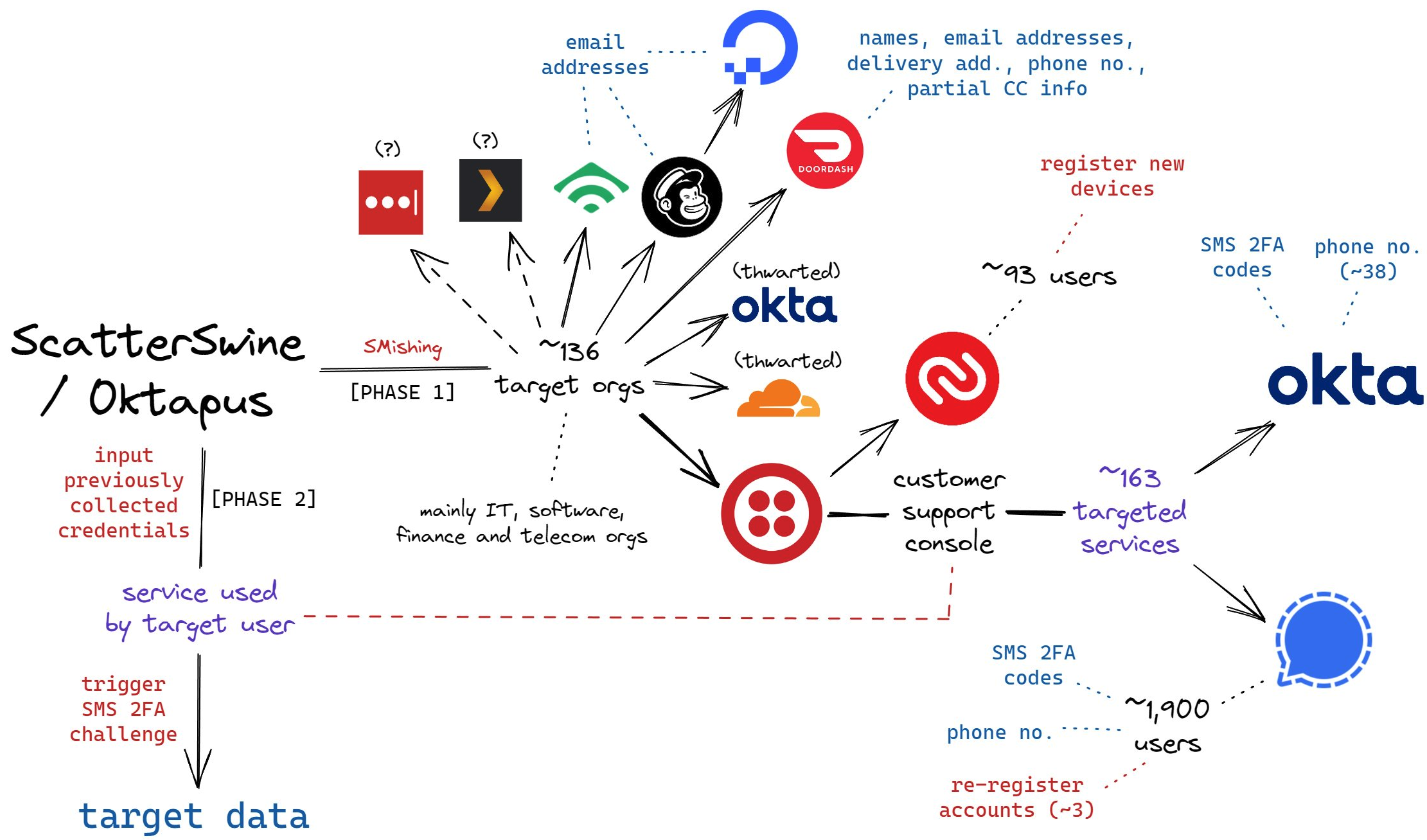
A flow chart of the attacks by the SMS phishing group known as 0ktapus and ScatterSwine. Image: Amitai Cohen for Wiz.io. twitter.com/amitaico.
The ubiquity of mobile phones became a lifeline for many companies trying to manage their remote employees throughout the Coronavirus pandemic. But these same mobile devices are fast becoming a liability for organizations that use them for phishable forms of multi-factor authentication, such as one-time codes generated by a mobile app or delivered via SMS.
Because as we can see from the success of this phishing group, this type of data extraction is now being massively automated, and employee authentication compromises can quickly lead to security and privacy risks for the employer’s partners or for anyone in their supply chain.
Unfortunately, a great many companies still rely on SMS for employee multi-factor authentication. According to a report this year from Okta, 47 percent of workforce customers deploy SMS and voice factors for multi-factor authentication. That’s down from 53 percent that did so in 2018, Okta found.
Some companies (like Knauer’s Sitel) have taken to requiring that all remote access to internal networks be managed through work-issued laptops and/or mobile devices, which are loaded with custom profiles that can’t be accessed through other devices.
Others are moving away from SMS and one-time code apps and toward requiring employees to use physical FIDO multi-factor authentication devices such as security keys, which can neutralize phishing attacks because any stolen credentials can’t be used unless the phishers also have physical access to the user’s security key or mobile device.
This came in handy for Twitter, which announced last year that it was moving all of its employees to using security keys, and/or biometric authentication via their mobile device. The phishers’ Telegram bot reported that on June 16, 2022, five employees at Twitter gave away their work credentials. In response to questions from KrebsOnSecurity, Twitter confirmed several employees were relieved of their employee usernames and passwords, but that its security key requirement prevented the phishers from abusing that information.
Twitter accelerated its plans to improve employee authentication following the July 2020 security incident, wherein several employees were phished and relieved of credentials for Twitter’s internal tools. In that intrusion, the attackers used Twitter’s tools to hijack accounts for some of the world’s most recognizable public figures, executives and celebrities — forcing those accounts to tweet out links to bitcoin scams.
“Security keys can differentiate legitimate sites from malicious ones and block phishing attempts that SMS 2FA or one-time password (OTP) verification codes would not,” Twitter said in an Oct. 2021 post about the change. “To deploy security keys internally at Twitter, we migrated from a variety of phishable 2FA methods to using security keys as our only supported 2FA method on internal systems.”
Update, 6:02 p.m. ET: Clarified that Cloudflare does not rely on TOTP (one-time multi-factor authentication codes) as a second factor for employee authentication.
Scammers are using invoices sent through PayPal.com to trick recipients into calling a number to dispute a pending charge. The missives — which come from Paypal.com and include a link at Paypal.com that displays an invoice for the supposed transaction — state that the user’s account is about to be charged hundreds of dollars. Recipients who call the supplied toll-free number to contest the transaction are soon asked to download software that lets the scammers assume remote control over their computer.
KrebsOnSecurity recently heard from a reader who received an email from paypal.com that he immediately suspected was phony. The message’s subject read, “Billing Department of PayPal updated your invoice.”

A copy of the phishing message included in the PayPal.com invoice.
While the phishing message attached to the invoice is somewhat awkwardly worded, there are many convincing aspects of this hybrid scam. For starters, all of the links in the email lead to paypal.com. Hovering over the “View and Pay Invoice” button shows the button indeed wants to load a link at paypal.com, and clicking that link indeed brings up an active invoice at paypal.com.
Also, the email headers in the phishing message (PDF) show that it passed all email validation checks as being sent by PayPal, and that it was sent through an Internet address assigned to PayPal.
Both the email and the invoice state that “there is evidence that your PayPal account has been accessed unlawfully.” The message continues:
“$600.00 has been debited to your account for the Walmart Gift Card purchase. This transaction will appear in the automatically deducted amount on PayPal activity after 24 hours. If you suspect you did not make this transaction, immediately contact us at the toll-free number….”
Here’s the invoice that popped up when the “View and Pay Invoice” button was clicked:
The reader who shared this phishing email said he logged into his PayPal account and could find no signs of the invoice in question. A call to the toll-free number listed in the invoice was received by a man who answered the phone as generic “customer service,” instead of trying to spoof PayPal or Walmart. Very quickly into the conversation he suggested visiting a site called globalquicksupport[.]com to download a remote administration tool. It was clear then where the rest of this call was going.
I can see this scam tricking a great many people, especially since both the email and invoice are sent through PayPal’s systems — which practically guarantees that the message will be successfully delivered. The invoices appear to have been sent from a compromised or fraudulent PayPal Business account, which allows users to send invoices like the one shown above. Details of this scam were shared Wednesday with PayPal’s anti-abuse (phishing@paypal.com) and media relations teams.
PayPal said in a written statement that phishing attempts are common and can take many forms.
“We have a zero-tolerance policy on our platform for attempted fraudulent activity, and our teams work tirelessly to protect our customers,” PayPal said. “We are aware of this well-known phishing scam and have put additional controls in place to mitigate this specific incident. Nonetheless, we encourage customers to always be vigilant online and to contact Customer Service directly if they suspect they are a target of a scam.”
It’s remarkable how well today’s fraudsters have adapted to hijacking the very same tools that financial institutions have long used to make their customers feel safe transacting online. It’s no accident that one of the most prolific scams going right now — the Zelle Fraud Scam — starts with a text message about an unauthorized payment that appears to come from your bank. After all, financial institutions have spent years encouraging customers to sign up for mobile alerts via SMS about suspicious transactions, and to expect the occasional inbound call about possibly fraudulent transactions.
Also, today’s scammers are less interested in stealing your PayPal login than they are in phishing your entire computer and online life with remote administration software, which seems to be the whole point of so many scams these days. Because why rob just one online account when you can plunder them all?
The best advice to sidestep phishing scams is to avoid clicking on links that arrive unbidden in emails, text messages and other mediums. Most phishing scams invoke a temporal element that warns of dire consequences should you fail to respond or act quickly. If you’re unsure whether the message is legitimate, take a deep breath and visit the site or service in question manually — ideally, using a browser bookmark to avoid potential typosquatting sites.
Earlier this month, the administrator of the cybercrime forum Breached received a cease-and-desist letter from a cybersecurity firm. The missive alleged that an auction on the site for data stolen from 10 million customers of Mexico’s second-largest bank was fake news and harming the bank’s reputation. The administrator responded to this empty threat by purchasing the stolen banking data and leaking it on the forum for everyone to download.
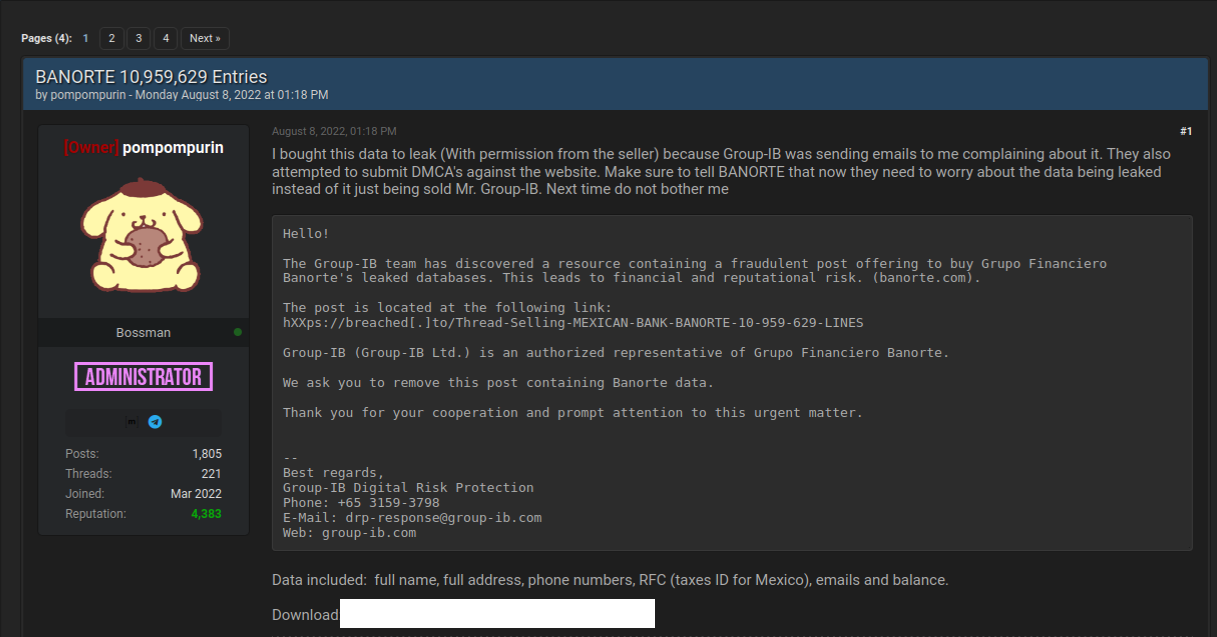
On August 3, 2022, someone using the alias “Holistic-K1ller” posted on Breached a thread selling data allegedly stolen from Grupo Financiero Banorte, Mexico’s second-biggest financial institution by total loans. Holistic-K1ller said the database included the full names, addresses, phone numbers, Mexican tax IDs (RFC), email addresses and balances on more than 10 million citizens.
There was no reason to believe Holistic-K1ller had fabricated their breach claim. This identity has been highly active on Breached and its predecessor RaidForums for more than two years, mostly selling databases from hacked Mexican entities. Last month, they sold customer information on 36 million customers of the Mexican phone company Telcel; in March, they sold 33,000 images of Mexican IDs — with the front picture and a selfie of each citizen. That same month, they also sold data on 1.4 million customers of Mexican lending platform Yotepresto.
But this history was either overlooked or ignored by Group-IB, the Singapore-based cybersecurity firm apparently hired by Banorte to help respond to the data breach.
“The Group-IB team has discovered a resource containing a fraudulent post offering to buy Grupo Financiero Banorte’s leaked databases,” reads a letter the Breach administrator said they received from Group-IB. “We ask you to remove this post containing Banorte data. Thank you for your cooperation and prompt attention to this urgent matter.”
The administrator of Breached is “Pompompurin,” the same individual who alerted this author in November 2021 to a glaring security hole in a U.S. Justice Department website that was used to spoof security alerts from the FBI. In a post to Breached on Aug. 8, Pompompurin said they bought the Banorte database from Holistic-K1ller’s sales thread because Group-IB was sending emails complaining about it.
“They also attempted to submit DMCA’s against the website,” Pompompurin wrote, referring to legal takedown requests under the Digital Millennium Copyright Act. “Make sure to tell Banorte that now they need to worry about the data being leaked instead of just being sold.”
Group-IB CEO Dmitriy Volkov said the company has seen some success in the past asking hackers to remove or take down certain information, but that making such requests is not a typical response for the security firm.
“It is not a common practice to send takedown notifications to such forums demanding that such content be removed,” Volkov said. “But these abuse letters are legally binding, which helps build a foundation for further steps taken by law enforcement agencies. Actions contrary to international rules in the regulated space of the Internet only lead to more severe crimes, which — as we know from the case of Raidforums — are successfully investigated and stopped by law enforcement.”
Banorte did not respond to requests for comment. But in a brief written statement picked up on Twitter, Banorte said there was no breach involving their infrastructure, and the data being sold is old.
“There has been no violation of our platforms and technological infrastructure,” Banorte said. “The set of information referred to is inaccurate and outdated, and does not put our users and customers at risk.”
That statement may be 100 percent true. Still, it is difficult to think of a better example of how not to do breach response. Banorte shrugging off this incident as a nothingburger is baffling: While it is almost certainly true that the bank balance information in the Banorte leak is now out of date, the rest of the information (tax IDs, phone numbers, email addresses) is harder to change.
“Is there one person from our community that think sending cease and desist letter to a hackers forum operator is a good idea?,” asked Ohad Zaidenberg, founder of CTI League, a volunteer emergency response community that emerged in 2020 to help fight COVID-19 related scams. “Who does it? Instead of helping, they pushed the organization from the hill.”
Kurt Seifried, director of IT for the CloudSecurityAlliance, was similarly perplexed by the response to the Banorte breach.
“If the data wasn’t real….did the bank think a cease and desist would result in the listing being removed?” Seifried wondered on Twitter. “I mean, isn’t selling breach data a worse crime usually than slander or libel? What was their thought process?”
A more typical response when a large bank suspects a breach is to approach the seller privately through an intermediary to ascertain if the information is valid and what it might cost to take it off the market. While it may seem odd to expect cybercriminals to make good on their claims to sell stolen data to only one party, removing sold stolen items from inventory is a fairly basic function of virtually all cybercriminal markets today (apart from perhaps sites that traffic in stolen identity data).
At a minimum, negotiating or simply engaging with a data seller can buy the victim organization additional time and clues with which to investigate the claim and ideally notify affected parties of a breach before the stolen data winds up online.
It is true that a large number of hacked databases put up for sale on the cybercrime underground are sold only after a small subset of in-the-know thieves have harvested all of the low-hanging fruit in the data — e.g., access to cryptocurrency accounts or user credentials that are recycled across multiple websites. And it’s certainly not unheard of for cybercriminals to go back on their word and re-sell or leak information that they have sold previously.
But companies in the throes of responding to a data security incident do themselves and customers no favors when they underestimate their adversaries, or try to intimidate cybercrooks with legal threats. Such responses generally accomplish nothing, except unnecessarily upping the stakes for everyone involved while displaying a dangerous naiveté about how the cybercrime underground works.
Update, Aug. 17, 10:32 a.m.: Thanks to a typo by this author, a request for comment sent to Group-IB was not delivered in advance of this story. The copy above has been updated to include a comment from Group-IB’s CEO.
The Department of Homeland Security (DHS) is urging states and localities to beef up security around proprietary devices that connect to the Emergency Alert System — a national public warning system used to deliver important emergency information, such as severe weather and AMBER alerts. The DHS warning came in advance of a workshop to be held this weekend at the DEFCON security conference in Las Vegas, where a security researcher is slated to demonstrate multiple weaknesses in the nationwide alert system.
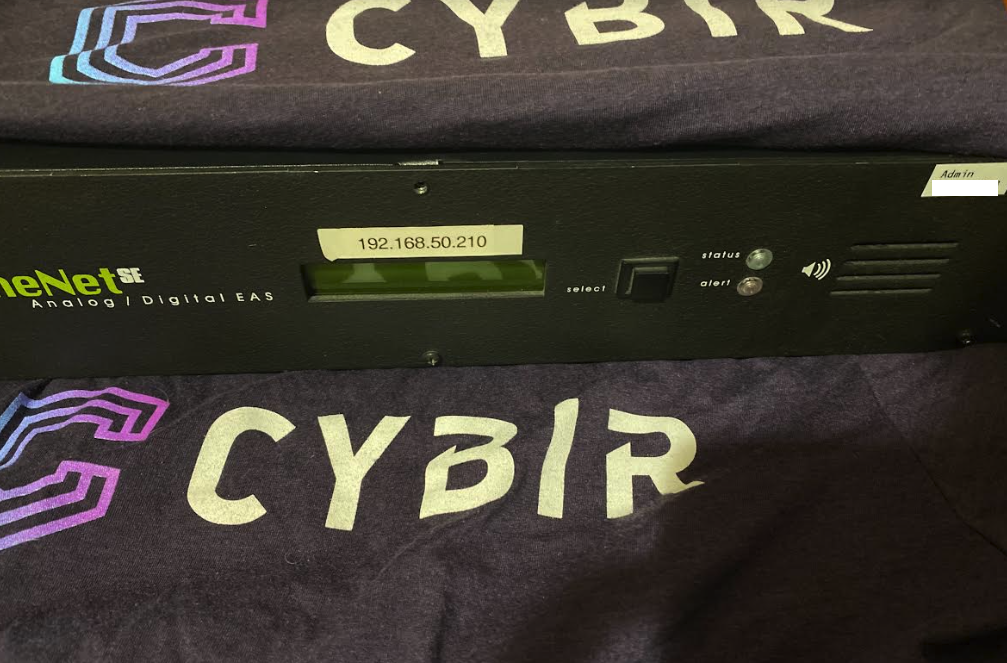
A Digital Alert Systems EAS encoder/decoder that Pyle said he acquired off eBay in 2019. It had the username and password for the system printed on the machine.
The DHS warning was prompted by security researcher Ken Pyle, a partner at security firm Cybir. Pyle said he started acquiring old EAS equipment off of eBay in 2019, and that he quickly identified a number of serious security vulnerabilities in a device that is broadly used by states and localities to encode and decode EAS alert signals.
“I found all kinds of problems back then, and reported it to the DHS, FBI and the manufacturer,” Pyle said in an interview with KrebsOnSecurity. “But nothing ever happened. I decided I wasn’t going to tell anyone about it yet because I wanted to give people time to fix it.”
Pyle said he took up the research again in earnest after an angry mob stormed the U.S. Capitol on Jan. 6, 2021.
“I was sitting there thinking, ‘Holy shit, someone could start a civil war with this thing,”’ Pyle recalled. “I went back to see if this was still a problem, and it turns out it’s still a very big problem. So I decided that unless someone actually makes this public and talks about it, clearly nothing is going to be done about it.”
The EAS encoder/decoder devices Pyle acquired were made by Lyndonville, NY-based Digital Alert Systems (formerly Monroe Electronics, Inc.), which issued a security advisory this month saying it released patches in 2019 to fix the flaws reported by Pyle, but that some customers are still running outdated versions of the device’s firmware. That may be because the patches were included in version 4 of the firmware for the EAS devices, and many older models apparently do not support the new software.
“The vulnerabilities identified present a potentially serious risk, and we believe both were addressed in software updates issued beginning Oct 2019,” EAS said in a written statement. “We also provided attribution for the researcher’s responsible disclosure, allowing us to rectify the matters before making any public statements. We are aware that some users have not taken corrective actions and updated their software and should immediately take action to update the latest software version to ensure they are not at risk. Anything lower than version 4.1 should be updated immediately. On July 20, 2022, the researcher referred to other potential issues, and we trust the researcher will provide more detail. We will evaluate and work to issue any necessary mitigations as quickly as possible.”
But Pyle said a great many EAS stakeholders are still ignoring basic advice from the manufacturer, such as changing default passwords and placing the devices behind a firewall, not directly exposing them to the Internet, and restricting access only to trusted hosts and networks.

Pyle, in a selfie that is heavily redacted because the EAS device behind him had its user credentials printed on the lid.
Pyle said the biggest threat to the security of the EAS is that an attacker would only need to compromise a single EAS station to send out alerts locally that can be picked up by other EAS systems and retransmitted across the nation.
“The process for alerts is automated in most cases, hence, obtaining access to a device will allow you to pivot around,” he said. “There’s no centralized control of the EAS because these devices are designed such that someone locally can issue an alert, but there’s no central control over whether I am the one person who can send or whatever. If you are a local operator, you can send out nationwide alerts. That’s how easy it is to do this.”
One of the Digital Alert Systems devices Pyle sourced from an electronics recycler earlier this year was non-functioning, but whoever discarded it neglected to wipe the hard drive embedded in the machine. Pyle soon discovered the device contained the private cryptographic keys and other credentials needed to send alerts through Comcast, the nation’s third-largest cable company.
“I can issue and create my own alert here, which has all the valid checks or whatever for being a real alert station,” Pyle said in an interview earlier this month. “I can create a message that will start propagating through the EAS.”
Comcast told KrebsOnSecurity that “a third-party device used to deliver EAS alerts was lost in transit by a trusted shipping provider between two Comcast locations and subsequently obtained by a cybersecurity researcher.
“We’ve conducted a thorough investigation of this matter and have determined that no customer data, and no sensitive Comcast data, were compromised,” Comcast spokesperson David McGuire said.
The company said it also confirmed that the information included on the device can no longer be used to send false messages to Comcast customers or used to compromise devices within Comcast’s network, including EAS devices.
“We are taking steps to further ensure secure transfer of such devices going forward,” McGuire said. “Separately, we have conducted a thorough audit of all EAS devices on our network and confirmed that they are updated with currently available patches and are therefore not vulnerable to recently reported security issues. We’re grateful for the responsible disclosure and to the security research community for continuing to engage and share information with our teams to make our products and technologies ever more secure. Mr. Pyle informed us promptly of his research and worked with us as we took steps to validate his findings and ensure the security of our systems.”

The user interface for an EAS device.
Unauthorized EAS broadcast alerts have happened enough that there is a chronicle of EAS compromises over at fandom.com. Thankfully, most of these incidents have involved fairly obvious hoaxes.
According to the EAS wiki, in February 2013, hackers broke into the EAS networks in Great Falls, Mt. and Marquette, Mich. to broadcast an alert that zombies had risen from their graves in several counties. In Feb. 2017, an EAS station in Indiana also was hacked, with the intruders playing the same “zombies and dead bodies” audio from the 2013 incidents.
“On February 20 and February 21, 2020, Wave Broadband’s EASyCAP equipment was hacked due to the equipment’s default password not being changed,” the Wiki states. “Four alerts were broadcasted, two of which consisted of a Radiological Hazard Warning and a Required Monthly Test playing parts of the Hip Hop song Hot by artist Young Thug.”
In January 2018, Hawaii sent out an alert to cell phones, televisions and radios, warning everyone in the state that a missile was headed their way. It took 38 minutes for Hawaii to let people know the alert was a misfire, and that a draft alert was inadvertently sent. The news video clip below about the 2018 event in Hawaii does a good job of walking through how the EAS works.